
1
1
CompuTherm LLC – www.computherm.com
Reading 2-D Ternary Phase Diagrams
• Isothermal Section
• Isopleth
• Liquidus Projection
• Lever Rule in Ternary Field

2
2
CompuTherm LLC – www.computherm.com
Reading 2-D Ternary Phase Diagrams
• Isothermal Section:
• Fixed Temperature
A
B
C
X
A
X
C
X
B
X
B
X
A
X
C
A
B
C
X
B
X
C
X
A
=1-X
B
-X
C
• Composition represented on
equilateral Triangle
• For low concentration of one
component, use a right-
angled triangle (e.g. Fe-Cr-C)

3
3
CompuTherm LLC – www.computherm.com
Reading 2-D Ternary Phase Diagrams
• Isothermal Section:
• Phase boundary (Blue)
• Tie-line (Green)
• Tie-triangle (Red)

4
4
CompuTherm LLC – www.computherm.com
Reading 2-D Ternary Phase Diagrams
• Isopleth:
• Y-axis: temperature
• X-axis: composition
• Tie-line may not lie
on the section

5
5
CompuTherm LLC – www.computherm.com
Reading 2-D Ternary Phase Diagrams
• Liquidus Projection:
• Univariant line (Blue)
• Isothermal line (Green)
• Primary phase region

6
6
CompuTherm LLC – www.computherm.com
Reading 2-D Ternary Phase Diagrams
• Isothermal Section:
• Lever rule on tie-line
a
g
Alloy
In Alloy P, two phases are in equilibrium:
Fraction of a = Length(PN) / Length(MN)
Fraction of γ = Length(MP) / Length(MN)
M
N
P

7
7
CompuTherm LLC – www.computherm.com
Reading 2-D Ternary Phase Diagrams
• Isothermal Section:
• Lever rule on tie-triangle
In Alloy P, three phases are in equilibrium:
Fraction of a = Area(PON) / Area(MNO)
Fraction of β = Area(PMN) / Area(MNO)
Fraction of γ = Area(POM) / Area(MNO)
a
g
Alloy
M
N
P
O
b

8
8
CompuTherm LLC – www.computherm.com
Types of Ternary Phase Diagrams
• Isomorphous System
• Ternary Three-phase Equilibrium
• Ternary Four-phase Equilibrium
• Class I Reaction
• Class II Reaction
• Class III Reaction
• Congruent Transformation
• A Complex System

9
9
CompuTherm LLC – www.computherm.com
Isomorphous Systems - Case I
Case I: Three binaries are all isomorphous with
Cigar shape phase boundaries.

10
10
CompuTherm LLC – www.computherm.com
Isomorphous Systems - Case I
Case I: Isothermal sections in decreasing T order.

11
11
CompuTherm LLC – www.computherm.com
Isomorphous Systems - Case I
Case I: Liquidus projection has no univariant line.
Liquidus Projection in 2-D view Liquidus Projection in 3-D view

12
12
CompuTherm LLC – www.computherm.com
Isomorphous Systems - Case I
Case I: Isopleths parallel to the B-C binary

13
13
CompuTherm LLC – www.computherm.com
Isomorphous Systems - Case I
Case I: Isopleths in 3-D view

14
14
CompuTherm LLC – www.computherm.com
Isomorphous Systems - Case I
Case I: Gibbs energy surface for Liquid at 700
o
C

15
15
CompuTherm LLC – www.computherm.com
Isomorphous Systems - Case II
Case II: Three binaries are all isomorphous with 2
Cigar shape phase boundaries and 1 maximum.

16
16
CompuTherm LLC – www.computherm.com
Isomorphous Systems - Case II
Case II: Isothermal sections in decreasing T order.

17
17
CompuTherm LLC – www.computherm.com
Isomorphous Systems - Case II
Case II: Liquidus projection has no univariant line.
Liquidus Projection in 2-D view Liquidus Projection in 3-D view

18
18
CompuTherm LLC – www.computherm.com
Isomorphous Systems - Case II
Case II: Isopleths parallel to the B-C binary

19
19
CompuTherm LLC – www.computherm.com
Isomorphous Systems - Case II
Case II: Isopleths in 3-D view

20
20
CompuTherm LLC – www.computherm.com
Isomorphous Systems - Case II
Case II: Gibbs energy surface for Liquid at 700
o
C

21
21
CompuTherm LLC – www.computherm.com
Isomorphous Systems - Case III
Case III: Three binaries are the same as those in
case I. There is a maximum melting point in the
ternary phase field.

22
22
CompuTherm LLC – www.computherm.com
Isomorphous Systems - Case III
Case III: Liquidus projection has no univariant line.
Liquidus Projection in 2-D view Liquidus Projection in 3-D view

23
23
CompuTherm LLC – www.computherm.com
Isomorphous Systems - Case III
Case III: Isopleths parallel to the B-C binary

24
24
CompuTherm LLC – www.computherm.com
Isomorphous Systems - Case III
Case III: Isopleths in 3-D view

25
25
CompuTherm LLC – www.computherm.com
Types of Ternary Phase Diagrams
• Isomorphous System
• Ternary Three-phase Equilibrium
• Ternary Four-phase Equilibrium
• Class I Reaction
• Class II Reaction
• Class III Reaction
• Congruent Transformation
• A Complex System

26
26
CompuTherm LLC – www.computherm.com
Ternary Three-Phase Equilibrium - Case I
Case I: Two eutectic binary systems and one
isomorphous with Cigar shape phase boundary.

27
27
CompuTherm LLC – www.computherm.com
Ternary Three-Phase Equilibrium - Case I
Case I: Isothermal sections in decreasing T order.

28
28
CompuTherm LLC – www.computherm.com
Ternary Three-Phase Equilibrium - Case I
Case I: Isothermal sections in decreasing T order.

29
29
CompuTherm LLC – www.computherm.com
Ternary Three-Phase Equilibrium - Case I
Liquidus has one univariant line starting from A-B
binary and ending at B-C binary, which separates
2 primary phase fields, Fcc and Bcc.

30
30
CompuTherm LLC – www.computherm.com
Ternary Three-Phase Equilibrium - Case I
Ternary phase fields in 3-D view
Liquid phase: Blue
Fcc phase: Red
Bcc phase: Orange

31
31
CompuTherm LLC – www.computherm.com
Ternary Three-Phase Equilibrium - Case I
Liquid+Fcc+Bcc Tie-triangle changes in ternary field
Liquid phase: Fuchsia
Fcc phase: Red
Bcc phase: Orange

32
32
CompuTherm LLC – www.computherm.com
Ternary Three-Phase Equilibrium - Case I
Isopleth through B-A
0.5
C
0.5
(Green line in 3D view)

33
33
CompuTherm LLC – www.computherm.com
Ternary Three-Phase Equilibrium - Case II
Case II: Two peritectic binary systems and one
isomorphous with Cigar shape phase boundary.

34
34
CompuTherm LLC – www.computherm.com
Ternary Three-Phase Equilibrium - Case II
Case II: Isothermal sections in decreasing T order.

35
35
CompuTherm LLC – www.computherm.com
Ternary Three-Phase Equilibrium - Case II
Liquidus has one univariant line starting from A-B
binary and ending at B-C binary, which separates
2 primary phase fields, Fcc and Bcc.

36
36
CompuTherm LLC – www.computherm.com
Ternary Three-Phase Equilibrium - Case II
Ternary phase fields in 3-D view
Liquid phase: Blue
Fcc phase: Red
Bcc phase: Orange

37
37
CompuTherm LLC – www.computherm.com
Ternary Three-Phase Equilibrium - Case II
Liquid+Fcc+Bcc Tie-triangle changes in ternary field
Liquid phase: Fuchsia
Fcc phase: Red
Bcc phase: Orange

38
38
CompuTherm LLC – www.computherm.com
Ternary Three-Phase Equilibrium - Case II
Isopleth through B-A
0.5
C
0.5
(Green line in 3D view)

39
39
CompuTherm LLC – www.computherm.com
Ternary Three-Phase Equilibrium - Case III
Case III: One peritectic binary, one eutectic
binary and one isomorphous with Cigar shape
phase boundary.

40
40
CompuTherm LLC – www.computherm.com
Ternary Three-Phase Equilibrium - Case III
Case III: Isothermal sections in decreasing T order.

41
41
CompuTherm LLC – www.computherm.com
Ternary Three-Phase Equilibrium - Case III
Liquidus has one univariant line starting from A-B
binary and ending at B-C binary, which separates
2 primary phase fields, Fcc and Bcc.

42
42
CompuTherm LLC – www.computherm.com
Ternary Three-Phase Equilibrium - Case III
Ternary phase fields in 3-D view
Liquid phase: Blue
Fcc phase: Red
Bcc phase: Orange

43
43
CompuTherm LLC – www.computherm.com
Ternary Three-Phase Equilibrium - Case III
Liquid+Fcc+Bcc Tie-triangle changes in ternary field
Liquid phase: Fuchsia
Fcc phase: Red
Bcc phase: Orange

44
44
CompuTherm LLC – www.computherm.com
Ternary Three-Phase Equilibrium - Case III
Isopleth through B-A
0.5
C
0.5
(Green line in 3D view)

45
45
CompuTherm LLC – www.computherm.com
Ternary Three-Phase Equilibrium - Case IV
Case IV: One eutectic binary and Two isomorphous
with Cigar shape phase boundary.

46
46
CompuTherm LLC – www.computherm.com
Ternary Three-Phase Equilibrium - Case IV
Case IV: Isothermal sections in decreasing T order.

47
47
CompuTherm LLC – www.computherm.com
Ternary Three-Phase Equilibrium - Case IV
Liquidus has one univariant line starting from A-
B binary and ending at a minimum in the ternary
field, and only one primary phase field, Fcc.

48
48
CompuTherm LLC – www.computherm.com
Ternary Three-Phase Equilibrium - Case IV
Ternary phase fields in 3-D view
Liquid phase: Blue
Fcc phase: Red

49
49
CompuTherm LLC – www.computherm.com
Ternary Three-Phase Equilibrium - Case IV
Liquid+Fcc+Fcc Tie-triangle changes in ternary field
Liquid phase: Fuchsia
Fcc phase: Red

50
50
CompuTherm LLC – www.computherm.com
Ternary Three-Phase Equilibrium - Case IV
Isopleth through B-A
0.9
C
0.1
(Green line in 3D view)

51
51
CompuTherm LLC – www.computherm.com
Ternary Three-Phase Equilibrium - Case V
Case V: One eutectic binary and Two isomorphous
with Cigar shape phase boundary.

52
52
CompuTherm LLC – www.computherm.com
Ternary Three-Phase Equilibrium - Case V
Case V: Isothermal sections in decreasing T order.

53
53
CompuTherm LLC – www.computherm.com
Ternary Three-Phase Equilibrium - Case V
Liquidus has one univariant line starting from a
maximum in the ternary field and ending at A-C
binary, and only one primary phase field, Fcc.

54
54
CompuTherm LLC – www.computherm.com
Ternary Three-Phase Equilibrium - Case V
Ternary phase fields in 3-D view
Liquid phase: Blue
Fcc phase: Red

55
55
CompuTherm LLC – www.computherm.com
Ternary Three-Phase Equilibrium - Case V
Liquid+Fcc+Fcc Tie-triangle changes in ternary field
Liquid phase: Fuchsia
Fcc phase: Red

56
56
CompuTherm LLC – www.computherm.com
Ternary Three-Phase Equilibrium - Case V
Isopleth through B
0.05
C
0.95
-A
0.95
B
0.05
(Green line in
3D view)

57
57
CompuTherm LLC – www.computherm.com
Ternary Three-Phase Equilibrium - Case VI
Case VI: Two eutectic binary systems and one
isomorphous with Cigar shape phase boundary.

58
58
CompuTherm LLC – www.computherm.com
Ternary Three-Phase Equilibrium - Case VI
Case VI: Isothermal sections in decreasing T order.

59
59
CompuTherm LLC – www.computherm.com
Ternary Three-Phase Equilibrium - Case VI
Liquidus lines start from a maximum in the ternary
field, go separately in opposite directions and end at
the two eutectic reactions in the binaries. Two
primary phase fields, Fcc and Bcc.

60
60
CompuTherm LLC – www.computherm.com
Ternary Three-Phase Equilibrium - Case VI
Ternary phase fields in 3-D view
Liquid phase: Blue
Fcc phase: Red
Bcc phase: Orange

61
61
CompuTherm LLC – www.computherm.com
Ternary Three-Phase Equilibrium - Case VI
Liquid+Fcc+Fcc Tie-triangle changes in ternary field
Liquid phase: Fuchsia
Fcc phase: Red
Bcc phase: Orange

62
62
CompuTherm LLC – www.computherm.com
Ternary Three-Phase Equilibrium - Case VI
Isopleth through B-A
0.5
C
0.5
(Green line in 3D view)

63
63
CompuTherm LLC – www.computherm.com
Ternary Three-Phase Equilibrium - Case VII
Case VII: The binaries are the same as those in Case
VI. Isothermal sections in decreasing T order.

64
64
CompuTherm LLC – www.computherm.com
Ternary Three-Phase Equilibrium - Case VII
Liquidus lines start from the two eutectic reactions in
the binaries, join together at a minimum in the
ternary field. Two primary phase fields, Fcc and Bcc.

65
65
CompuTherm LLC – www.computherm.com
Ternary Three-Phase Equilibrium - Case VII
Ternary phase fields in 3-D view
Liquid phase: Blue
Fcc phase: Red
Bcc phase: Orange

66
66
CompuTherm LLC – www.computherm.com
Ternary Three-Phase Equilibrium - Case VII
Liquid+Fcc+Fcc Tie-triangle changes in ternary field
Liquid phase: Fuchsia
Fcc phase: Red
Bcc phase: Orange

67
67
CompuTherm LLC – www.computherm.com
Ternary Three-Phase Equilibrium - Case VII
Isopleth through B-A
0.5
C
0.5
(Green line in 3D view)

68
68
CompuTherm LLC – www.computherm.com
Types of Ternary Phase Diagrams
• Isomorphous System
• Ternary Three-phase Equilibrium
• Ternary Four-phase Equilibrium
• Class I Reaction
• Class II Reaction
• Class III Reaction
• Congruent Transformation
• A Complex System

69
69
CompuTherm LLC – www.computherm.com
Ternary Four-Phase Equilibrium – Class I
Class I: Three eutectic binary systems.

70
70
CompuTherm LLC – www.computherm.com
Ternary Four-Phase Equilibrium – Class I
Class I: Isothermal sections in decreasing T order.

71
71
CompuTherm LLC – www.computherm.com
Ternary Four-Phase Equilibrium – Class I
Liquidus lines start from the three eutectic reactions in
the binaries, join together at one point in the ternary
field. Three primary phase fields, Fcc, Bcc and Hcp.

72
72
CompuTherm LLC – www.computherm.com
Ternary Four-Phase Equilibrium – Class I
Ternary phase fields in 3-D view
Liquid phase: Blue
Fcc phase: Red
Bcc phase: Orange
Hcp phase: Fuchsia
Invariant: Aqua

73
73
CompuTherm LLC – www.computherm.com
Ternary Four-Phase Equilibrium – Class I
Liquid involved Tie-triangle changes in ternary field
Liquid phase: Blue
Fcc phase: Red
Bcc phase: Orange
Hcp phase: Fuchsia
Invariant: Green

74
74
CompuTherm LLC – www.computherm.com
Ternary Four-Phase Equilibrium – Class I
Isopleths through 40 at.% C and 50 at.% C

75
75
CompuTherm LLC – www.computherm.com
Ternary Four-Phase Equilibrium – Class I
Isopleths through B-A
0.6
C
0.4
and B-A
0.415
C
0.585

76
76
CompuTherm LLC – www.computherm.com
Ternary Four-Phase Equilibrium – Class I
Characteristics to determine whether it is a Class
I four-phase equilibrium:
Before Reaction: 3 three-phase triangles
After Reaction: 1 three-phase triangle
Class I reaction: Φ => a + β + γ
Φ+a+β
Φ+a+γ
Φ+β+γ
Before Reaction
a
β
γ
Φ
a+β+γ
After Reaction
a
β
γ

77
77
CompuTherm LLC – www.computherm.com
Ternary Four-Phase Equilibrium – Class I
Class I, Case 2: Four-phase equilibrium with two
liquids involved, One monotectic, one eutectic
and one isomorphous binary systems.

78
78
CompuTherm LLC – www.computherm.com
Ternary Four-Phase Equilibrium – Class I
Class I: Isothermal sections in decreasing T order.

79
79
CompuTherm LLC – www.computherm.com
Ternary Four-Phase Equilibrium – Class I
Class I: Enlarged isothermal sections before and
after the Class I invariant reaction.
L
1
=> L
2
+ Bcc + Fcc

80
80
CompuTherm LLC – www.computherm.com
Ternary Four-Phase Equilibrium – Class I
Liquidus lines are separated into two parts:
A-rich part starts from the monotectic and eutectic reactions in A-B binary
and the liquid miscibility gap in ternary field, join together at the invariant
reaction.
A-poor part starts from the monotectic reaction in A-B binary, joins with the
liquid miscibility gap in ternary field and then ends in eutectic reaction in B-
C binary.

81
81
CompuTherm LLC – www.computherm.com
Ternary Four-Phase Equilibrium – Class I
Ternary phase fields in 3-D view
Liquid phase: Blue
Fcc phase: Red
Bcc phase: Orange
Hcp phase: Fuchsia
Invariant: Aqua

82
82
CompuTherm LLC – www.computherm.com
Ternary Four-Phase Equilibrium – Class I
Liquid involved Tie-triangle changes in ternary field
Liquid phase: Blue
Fcc phase: Red
Bcc phase: Fuchsia
Invariant: Green

83
83
CompuTherm LLC – www.computherm.com
Types of Ternary Phase Diagrams
• Isomorphous System
• Ternary Three-phase Equilibrium
• Ternary Four-phase Equilibrium
• Class I Reaction
• Class II Reaction
• Class III Reaction
• Congruent Transformation
• A Complex System

84
84
CompuTherm LLC – www.computherm.com
Ternary Four-Phase Equilibrium – Class II
Class II: Two eutectic binary and one peritectic
binary systems.

85
85
CompuTherm LLC – www.computherm.com
Ternary Four-Phase Equilibrium – Class II
Class II: Isothermal sections in decreasing T order.

86
86
CompuTherm LLC – www.computherm.com
Ternary Four-Phase Equilibrium – Class II
Liquidus lines start from the peritectic reaction in A-B binary
and the eutectic reaction in A-C binary, join together at one
point in the ternary field and then go to the eutectic reaction
in B-C binary. Three primary phase fields, Fcc, Bcc and Hcp.

87
87
CompuTherm LLC – www.computherm.com
Ternary Four-Phase Equilibrium – Class II
Ternary phase fields in 3-D view
Liquid phase: Blue
Fcc phase: Red
Bcc phase: Orange
Hcp phase: Fuchsia
Invariant: Aqua

88
88
CompuTherm LLC – www.computherm.com
Ternary Four-Phase Equilibrium – Class II
Liquid involved Tie-triangle changes in ternary field
Liquid phase: Blue
Fcc phase: Red
Bcc phase: Orange
Hcp phase: Fuchsia
Invariant: Green

89
89
CompuTherm LLC – www.computherm.com
Ternary Four-Phase Equilibrium – Class II
Isopleths through 25 at.% A and 20 at.% A

90
90
CompuTherm LLC – www.computherm.com
Ternary Four-Phase Equilibrium – Class II
Characteristics to determine whether it is a Class
II four-phase equilibrium:
Before Reaction: 2 three-phase triangles
After Reaction: 2 three-phase triangles
Class II reaction: Φ + a => β + γ
Φ+a+β
Φ+a+γ
Before Reaction
a
β
γ
Φ
Φ+β+γ
a+β+γ
After Reaction
a
β
γ
Φ

91
91
CompuTherm LLC – www.computherm.com
Ternary Four-Phase Equilibrium – Class II
Class II, Case 2: Four phase equilibrium with two
liquids involved, One monotectic, one eutectic
and one isomorphous binary systems.

92
92
CompuTherm LLC – www.computherm.com
Ternary Four-Phase Equilibrium – Class II
Class II: Isothermal sections in decreasing T order.

93
93
CompuTherm LLC – www.computherm.com
Ternary Four-Phase Equilibrium – Class II
Class II: Enlarged isothermal sections before and
after the type II invariant reaction.
L
1
+ Bcc => L
2
+ Fcc

94
94
CompuTherm LLC – www.computherm.com
Ternary Four-Phase Equilibrium – Class II
Liquidus lines are separated into two parts:
A-rich part starts from the monotectic and eutectic reactions in A-B binary,
join together at the invariant reaction and then ends at the liquid miscibility
gap in ternary field.
A-poor part starts from the monotectic reaction in A-B binary, separate into
two directions after invariant reaction, one ends at the liquid miscibility gap
in ternary field and the other ends in eutectic reaction in B-C binary.

95
95
CompuTherm LLC – www.computherm.com
Ternary Four-Phase Equilibrium – Class II
Ternary phase fields in 3-D view
Liquid phase: Blue
Fcc phase: Red
Bcc phase: Orange
Hcp phase: Fuchsia
Invariant: Aqua

96
96
CompuTherm LLC – www.computherm.com
Ternary Four-Phase Equilibrium – Class II
Liquid involved Tie-triangle changes in ternary field
Liquid phase: Blue
Fcc phase: Red
Bcc phase: Fuchsia
Invariant: Green

97
97
CompuTherm LLC – www.computherm.com
Types of Ternary Phase Diagrams
• Isomorphous System
• Ternary Three-phase Equilibrium
• Ternary Four-phase Equilibrium
• Class I Reaction
• Class II Reaction
• Class III Reaction
• Congruent Transformation
• A Complex System

98
98
CompuTherm LLC – www.computherm.com
Ternary Four-Phase Equilibrium – Class III
Class III: One eutectic binary and two peritectic
binary systems.

99
99
CompuTherm LLC – www.computherm.com
Ternary Four-Phase Equilibrium – Class III
Class III: Isothermal sections in decreasing T order.

100
100
CompuTherm LLC – www.computherm.com
Ternary Four-Phase Equilibrium – Class III
Liquidus lines start from the eutectic reaction in A-B binary,
split into two directions in the ternary field and end at the
peritectic reactions in A-C and B-C binaries. Three primary
phase fields, Fcc, Bcc and Hcp.

101
101
CompuTherm LLC – www.computherm.com
Ternary Four-Phase Equilibrium – Class III
Ternary phase fields in 3-D view
Liquid phase: Blue
Fcc phase: Red
Bcc phase: Orange
Hcp phase: Fuchsia
Invariant: Aqua

102
102
CompuTherm LLC – www.computherm.com
Ternary Four-Phase Equilibrium – Class III
Liquid involved Tie-triangle changes in ternary field
Liquid phase: Blue
Fcc phase: Red
Bcc phase: Orange
Hcp phase: Fuchsia
Invariant: Green

103
103
CompuTherm LLC – www.computherm.com
Ternary Four-Phase Equilibrium – Class III
Isopleths through 65 at.% C and 72 at.% C

104
104
CompuTherm LLC – www.computherm.com
Ternary Four-Phase Equilibrium – Class III
Characteristics to determine whether it is a Class
III four-phase equilibrium:
Before Reaction: 1 three-phase triangle
After Reaction: 3 three-phase triangles
Class III reaction: a + β + γ => Φ
Φ+a+β
Φ+a+γ
Φ+β+γ
After Reaction
a
β
γ
Φ
a+β+γ
Before Reaction
a
β
γ

105
105
CompuTherm LLC – www.computherm.com
Types of Ternary Phase Diagrams
• Isomorphous System
• Ternary Three-phase Equilibrium
• Ternary Four-phase Equilibrium
• Class I Reaction
• Class II Reaction
• Class III Reaction
• Congruent Transformation
• A Complex System

106
106
CompuTherm LLC – www.computherm.com
Congruent Transformation – Case I
Case I: Congruent melting in one binary and form
a pseudo-binary in the ternary field.

107
107
CompuTherm LLC – www.computherm.com
Congruent Transformation – Case I
Case I: Isothermal sections in decreasing T order.

108
108
CompuTherm LLC – www.computherm.com
Congruent Transformation – Case I
Case I: Isothermal sections in decreasing T order.

109
109
CompuTherm LLC – www.computherm.com
Congruent Transformation – Case I
The isopleth through A
0.5
B
0.5
-C is a pseudo-binary system.

110
110
CompuTherm LLC – www.computherm.com
Congruent Transformation – Case I
The isopleth through A
0.5
B
0.5
-C cuts the liquidus projection
into two parts and each one contains a class I four-phase
equilibrium. The red point is a maximum in the liquidus
surface.

111
111
CompuTherm LLC – www.computherm.com
Congruent Transformation – Case I
Ternary phase fields in 3-D view
Liquid phase: Blue
Fcc phase: Red
Bcc phase: Orange
Hcp phase: Fuchsia
Delta phase: Pink
Invariant: Aqua
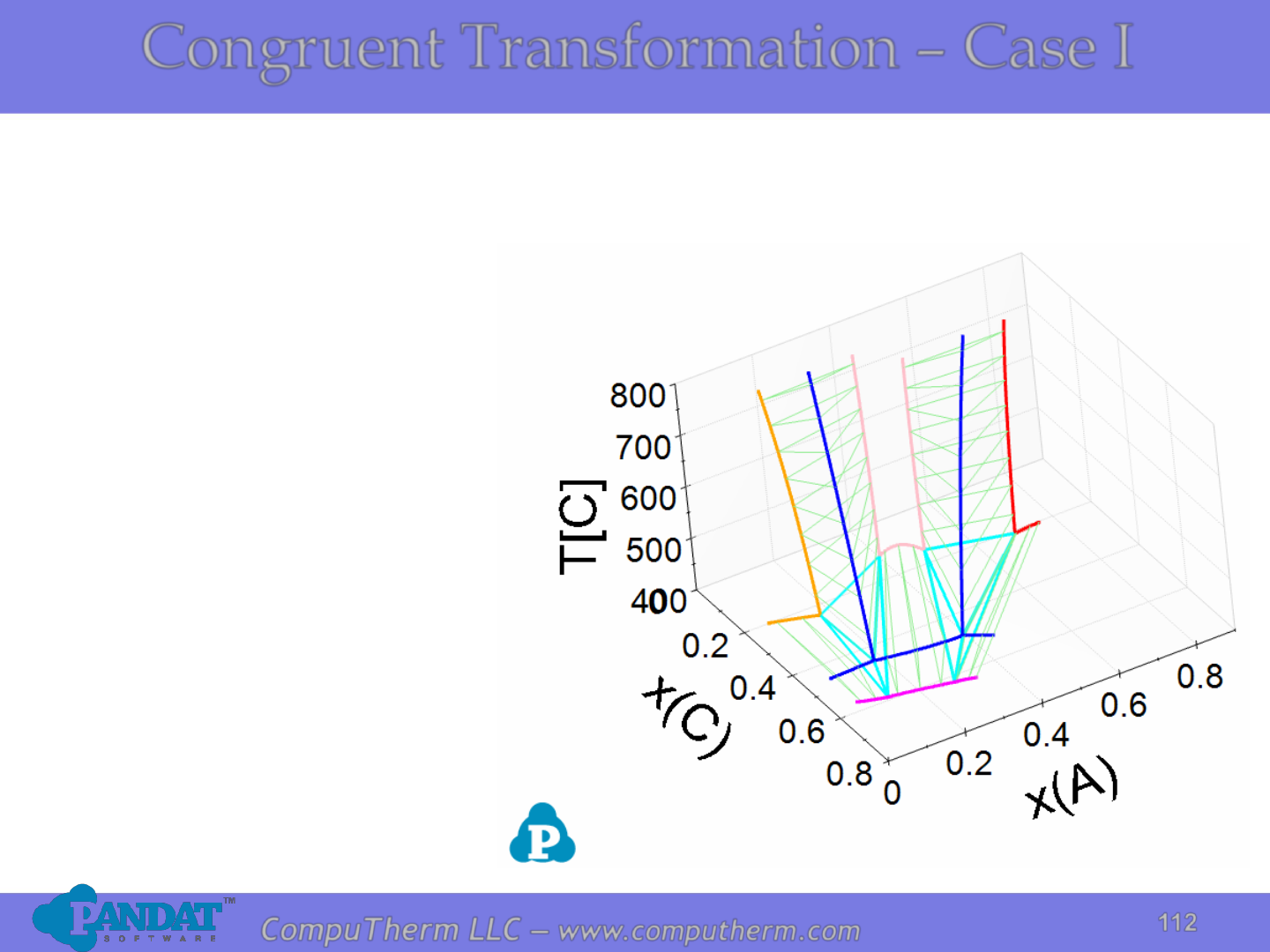
112
112
CompuTherm LLC – www.computherm.com
Congruent Transformation – Case I
Liquid involved Tie-triangle changes in ternary field
Liquid phase: Blue
Fcc phase: Red
Bcc phase: Orange
Hcp phase: Fuchsia
Delta phase: Pink
Invariant: Aqua
Tie-triangle: Green
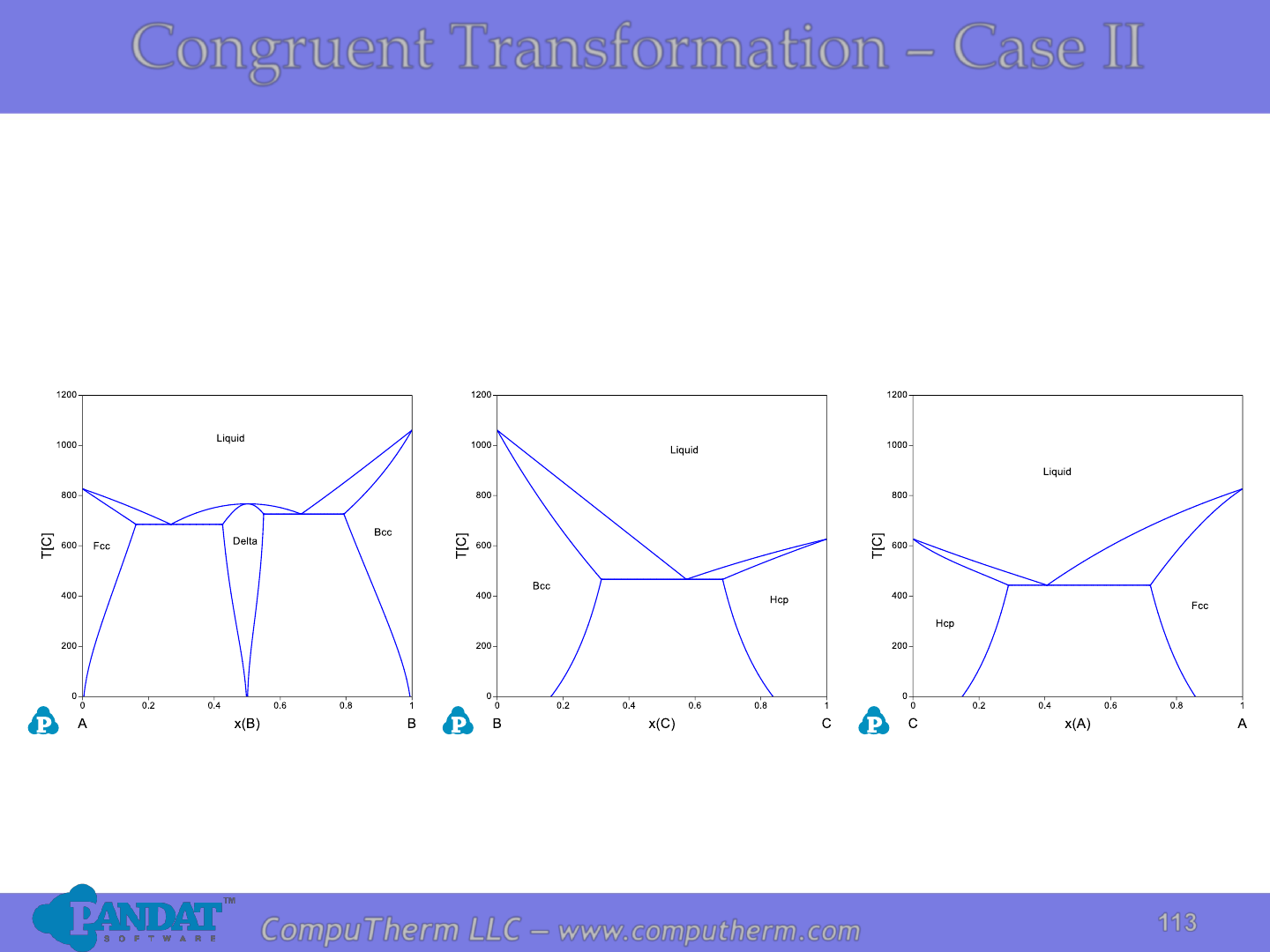
113
113
CompuTherm LLC – www.computherm.com
Congruent Transformation – Case II
Case II: Congruent melting in one binary but do
not form a pseudo-binary in the ternary field.
Binaries are the same as in Case I.
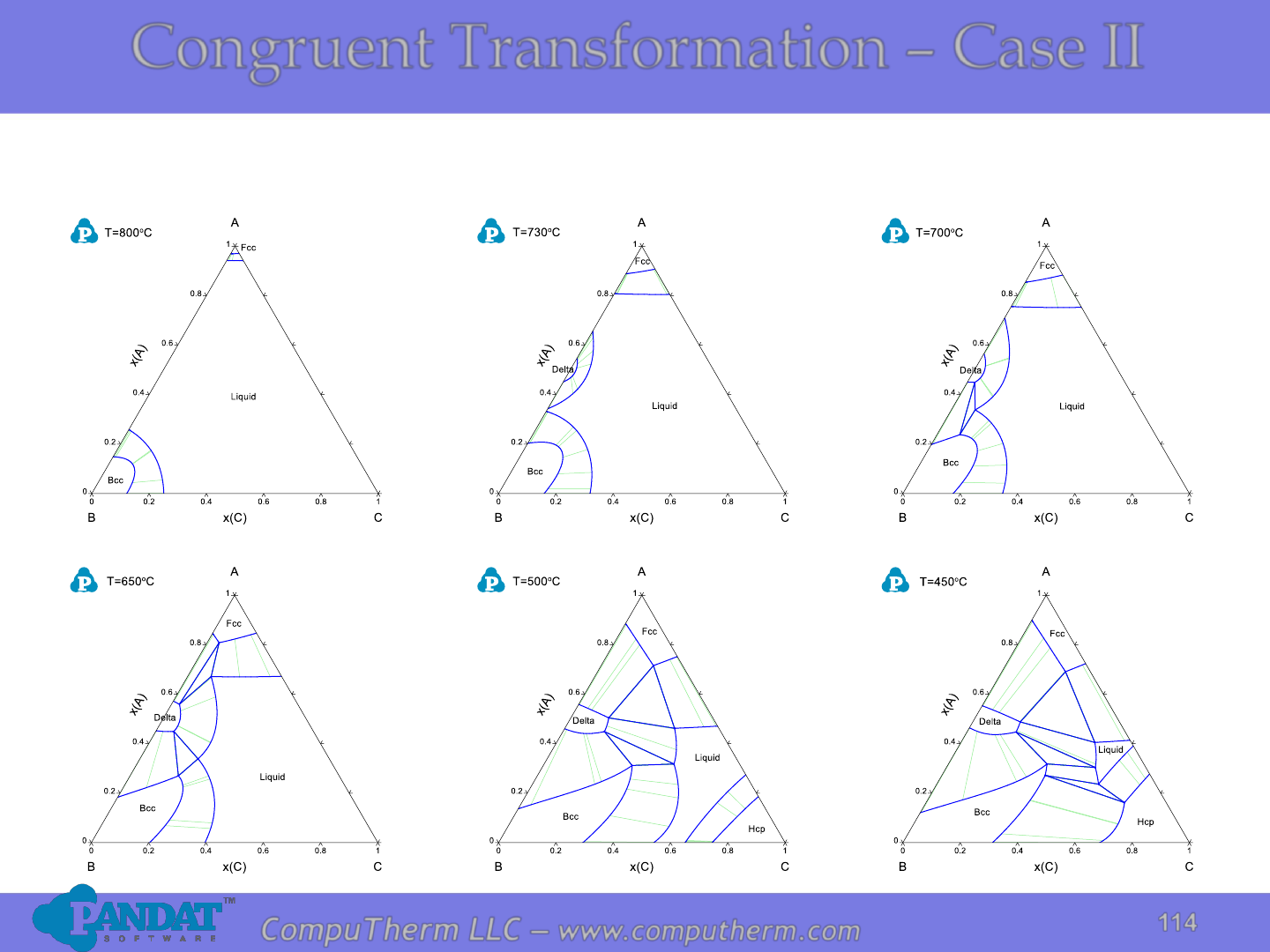
114
114
CompuTherm LLC – www.computherm.com
Congruent Transformation – Case II
Case II: Isothermal sections in decreasing T order.
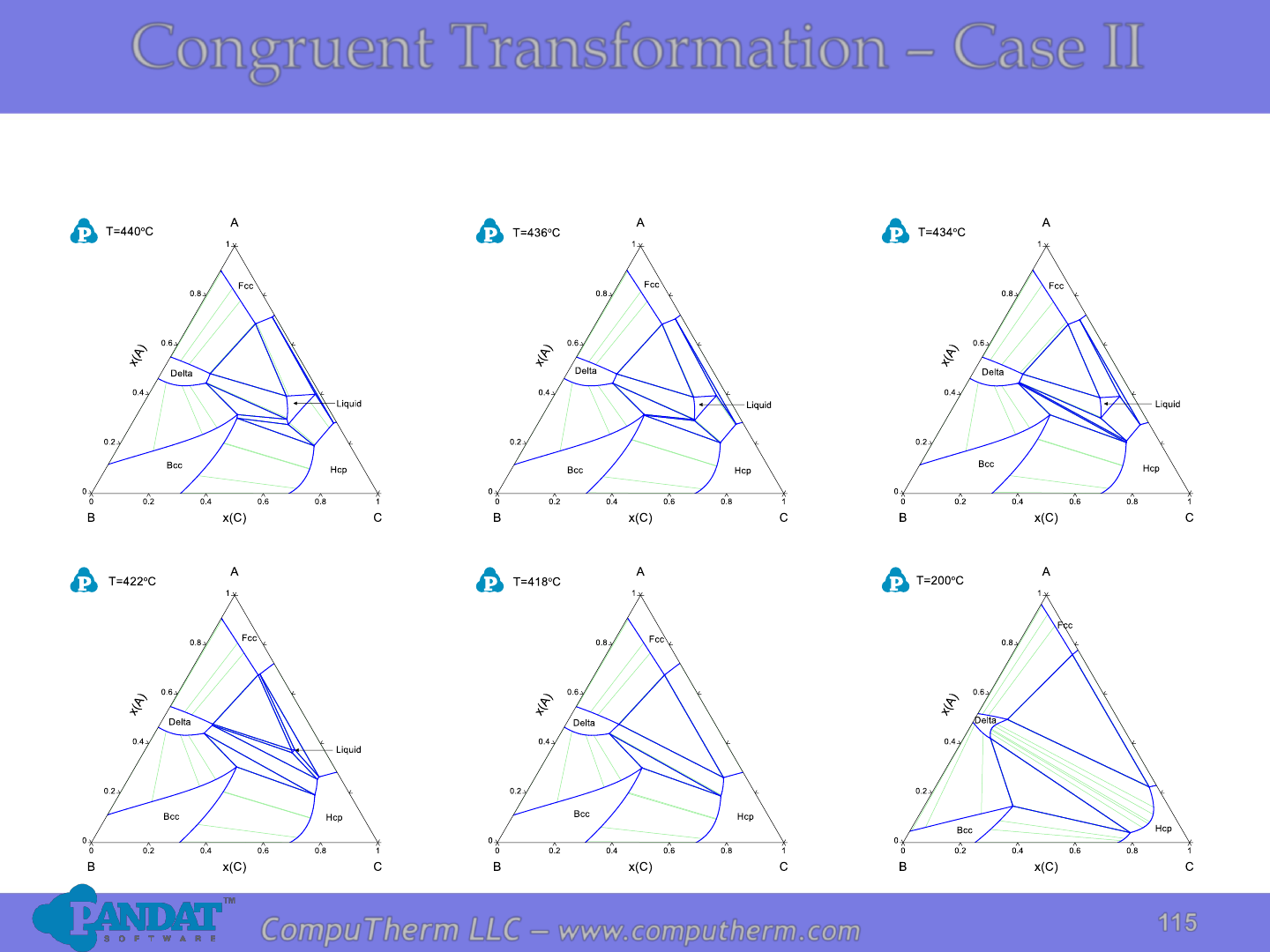
115
115
CompuTherm LLC – www.computherm.com
Congruent Transformation – Case II
Case II: Isothermal sections in decreasing T order.
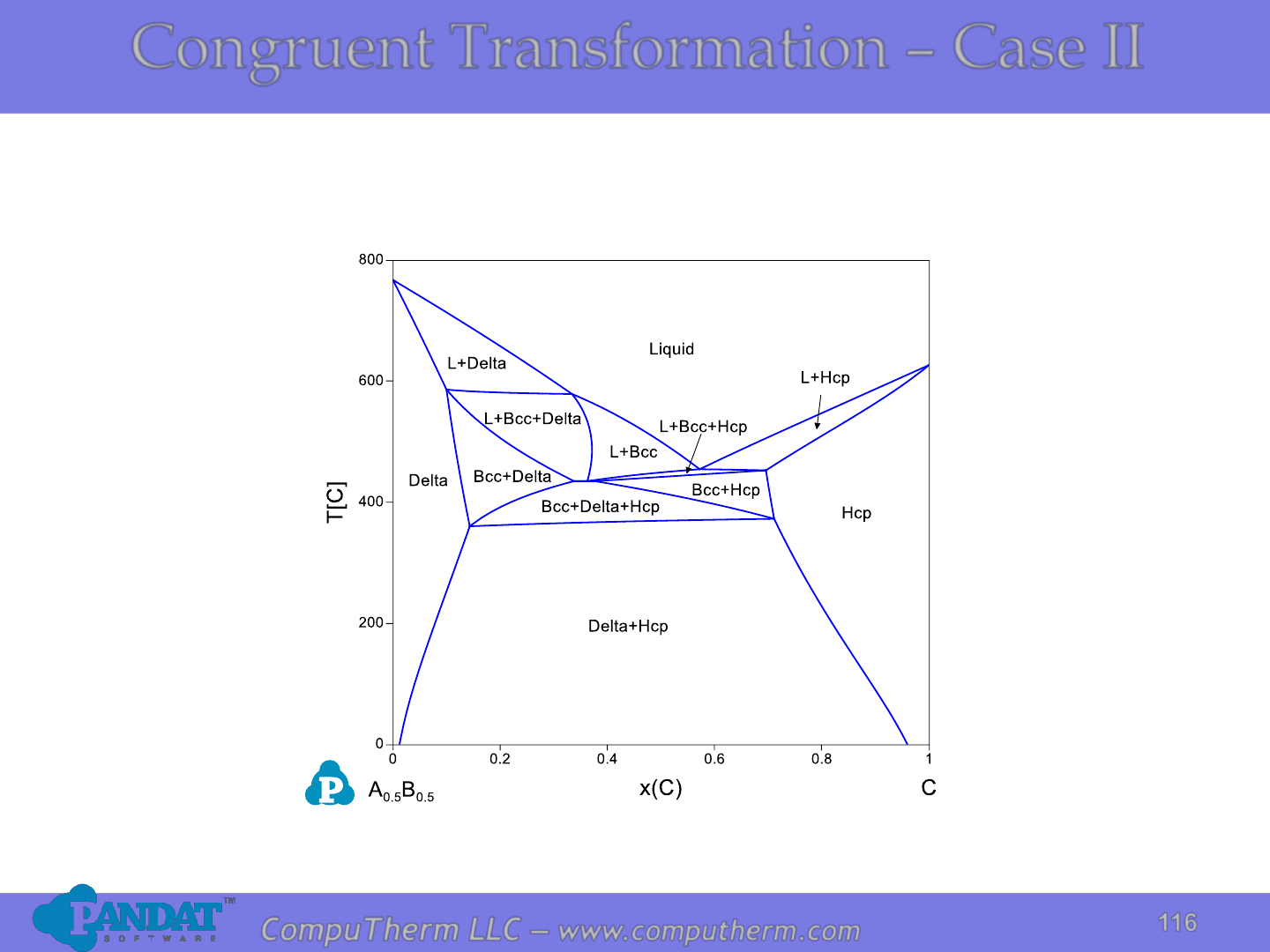
116
116
CompuTherm LLC – www.computherm.com
Congruent Transformation – Case II
The isopleth through A
0.5
B
0.5
-C is not a pseudo-binary system.
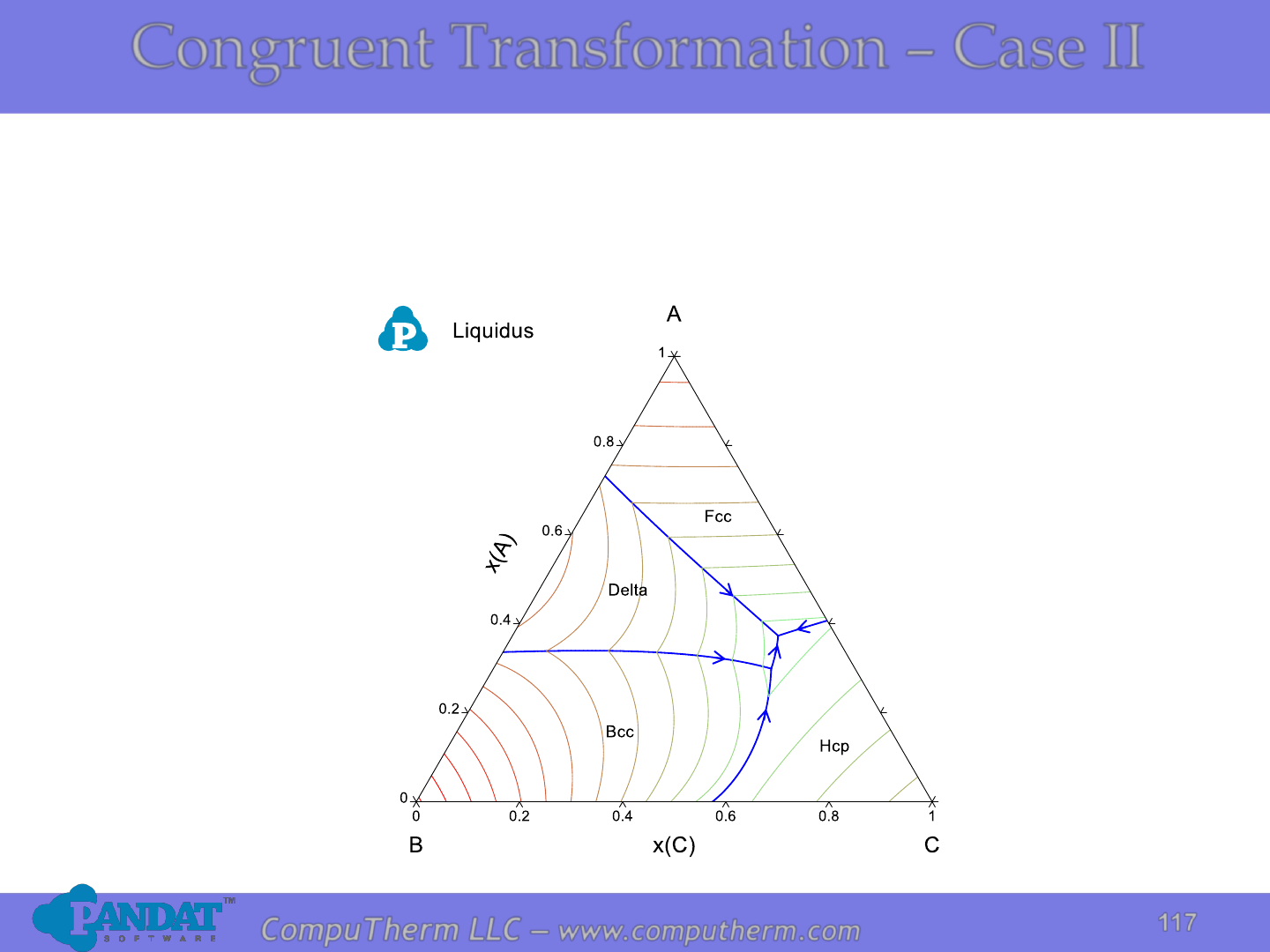
117
117
CompuTherm LLC – www.computherm.com
Congruent Transformation – Case II
The liquidus projection contains one class I four-phase
equilibrium and one class II four-phase equilibrium.
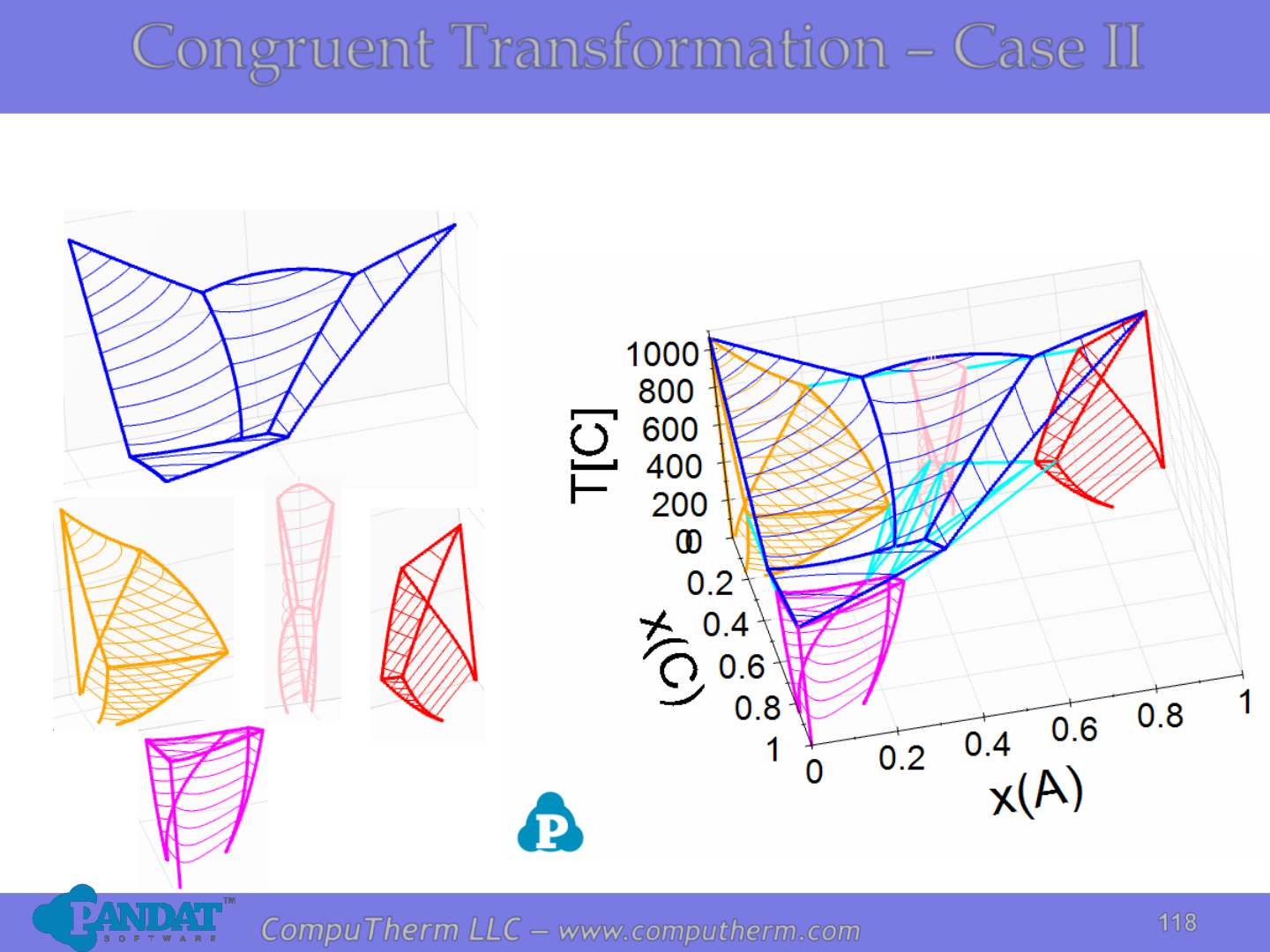
118
118
CompuTherm LLC – www.computherm.com
Congruent Transformation – Case II
Ternary phase fields in 3-D view
Liquid phase: Blue
Fcc phase: Red
Bcc phase: Orange
Hcp phase: Fuchsia
Delta phase: Pink
Invariant: Aqua
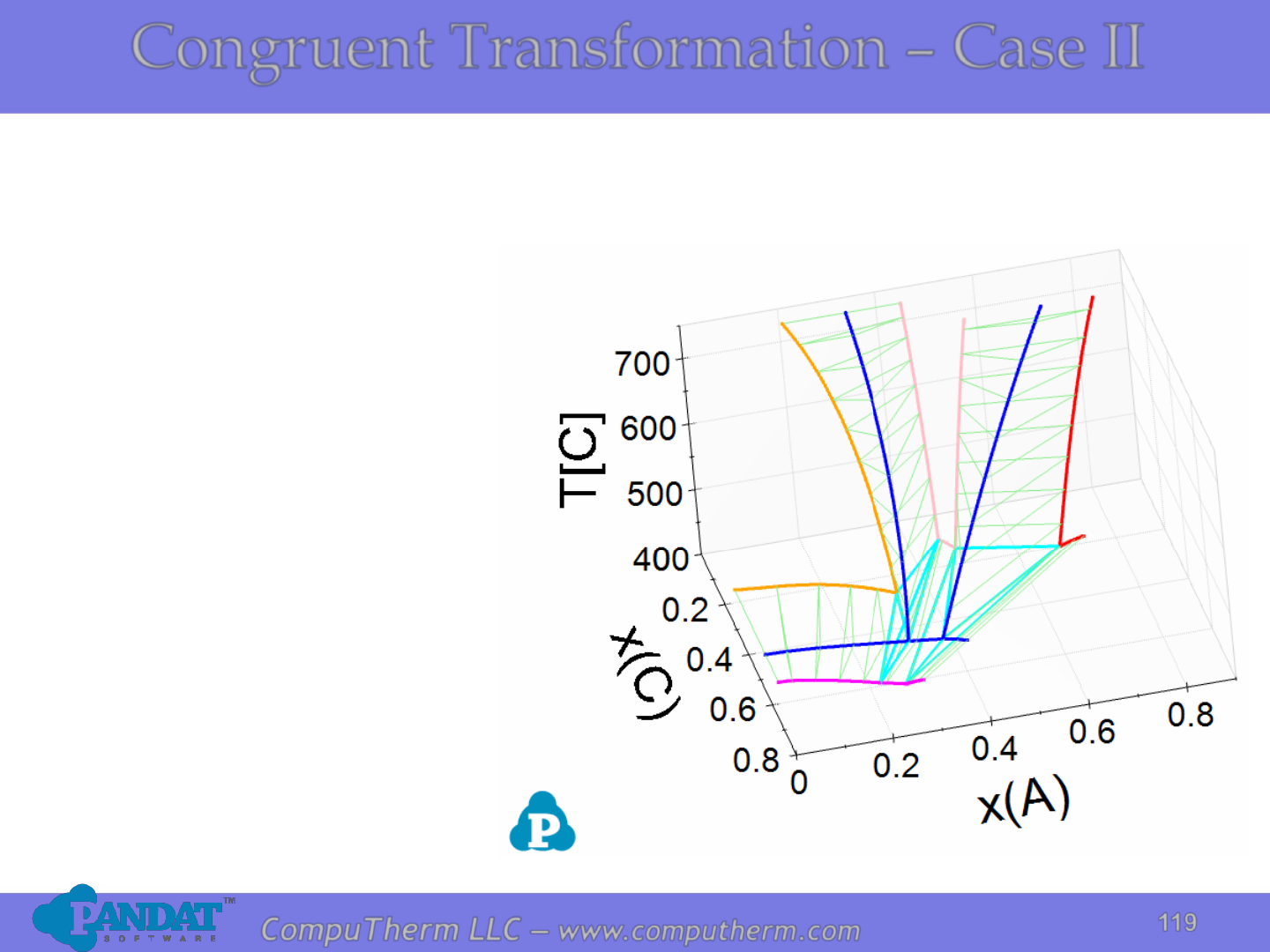
119
119
CompuTherm LLC – www.computherm.com
Congruent Transformation – Case II
Liquid involved Tie-triangle changes in ternary field
Liquid phase: Blue
Fcc phase: Red
Bcc phase: Orange
Hcp phase: Fuchsia
Delta phase: Pink
Invariant: Aqua
Tie-triangle: Green
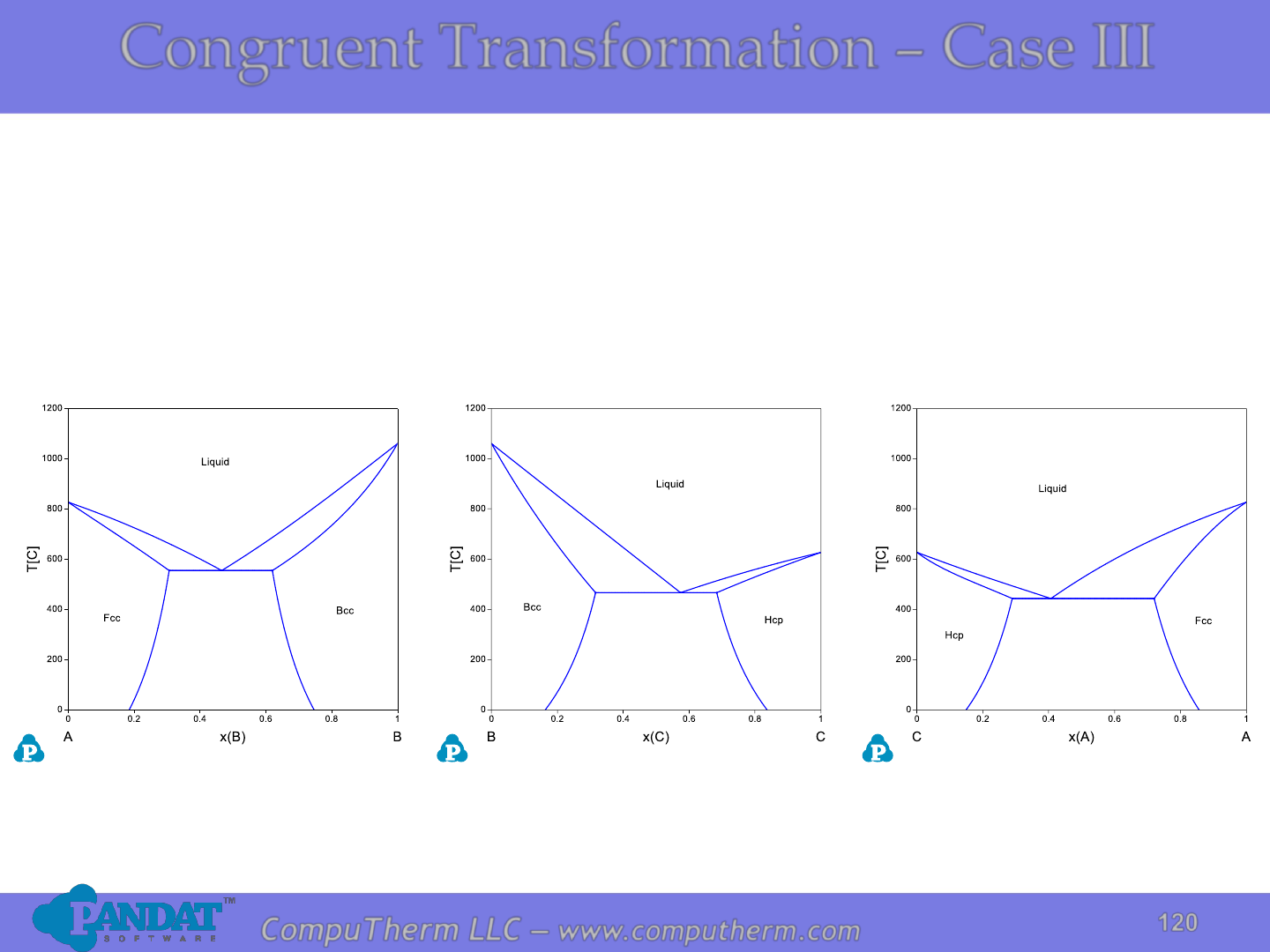
120
120
CompuTherm LLC – www.computherm.com
Congruent Transformation – Case III
Case III: Binaries are all eutectic systems, and
there is a ternary compound which melts
congruently in the ternary field.
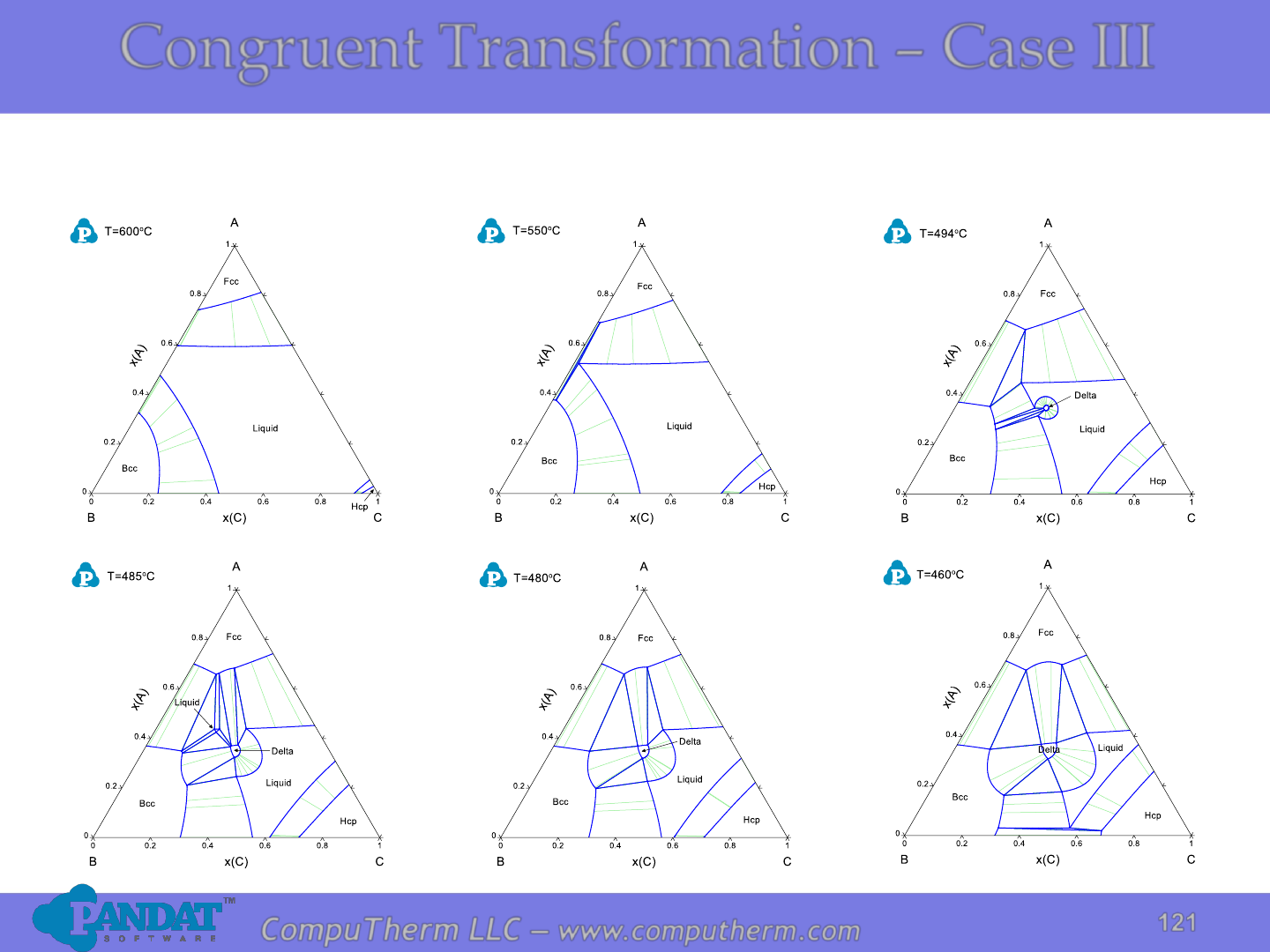
121
121
CompuTherm LLC – www.computherm.com
Congruent Transformation – Case III
Case III: Isothermal sections in decreasing T order.
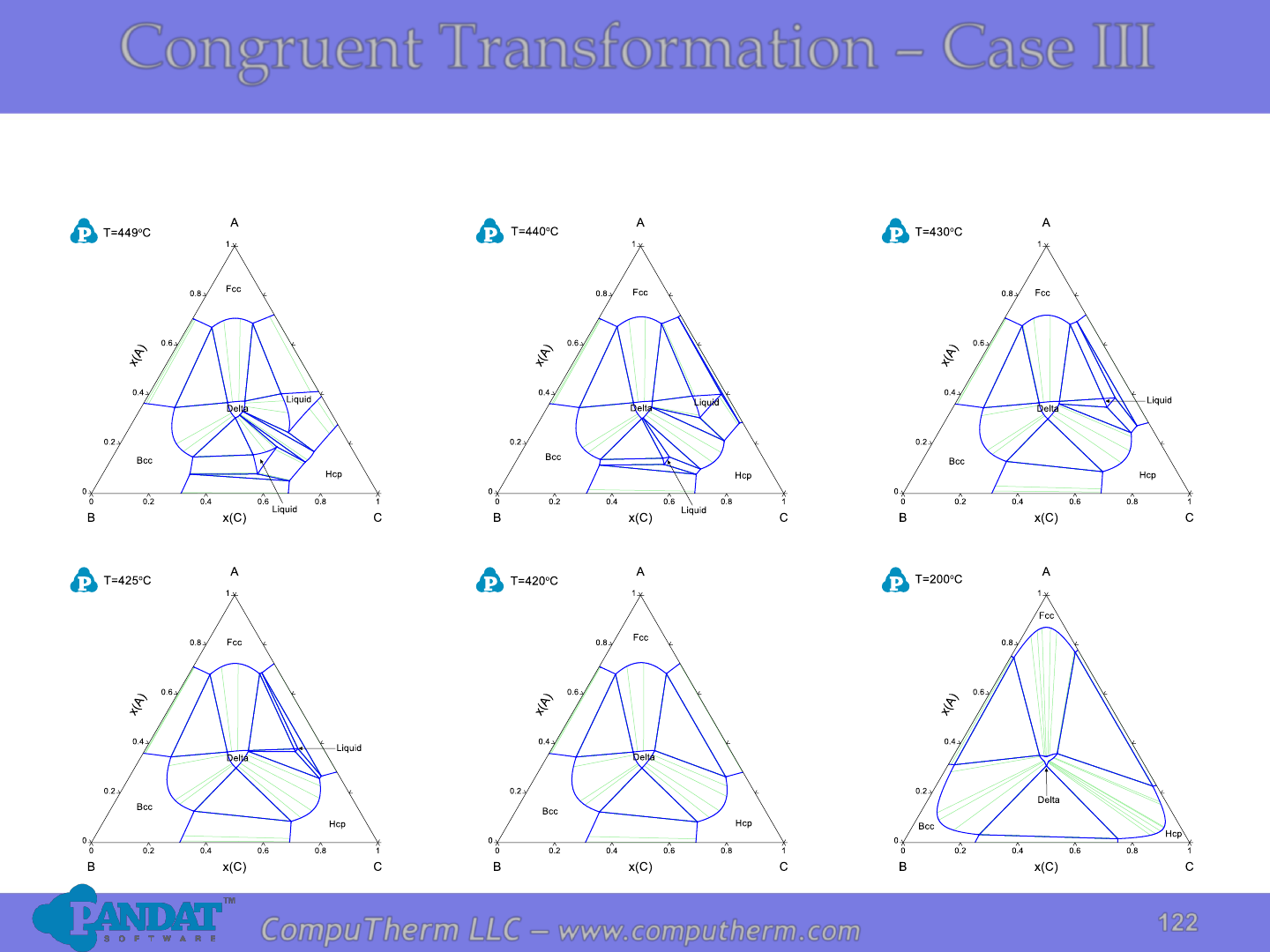
122
122
CompuTherm LLC – www.computherm.com
Congruent Transformation – Case III
Case III: Isothermal sections in decreasing T order.
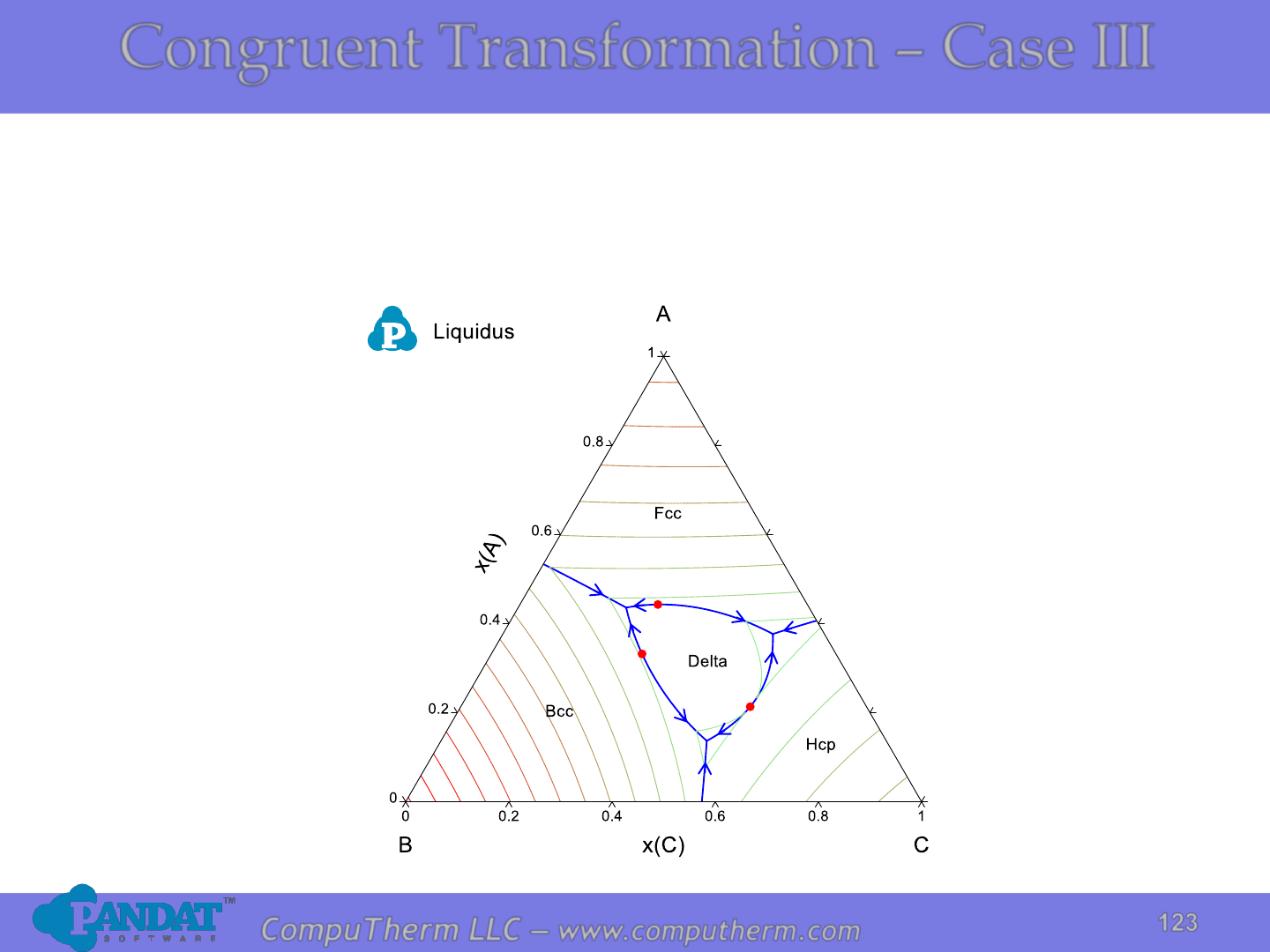
123
123
CompuTherm LLC – www.computherm.com
Congruent Transformation – Case III
The delta primary phase appears as an island in the ternary
field and there are three class I four-phase equilibria. The red
points are three maximums in the liquidus surface.
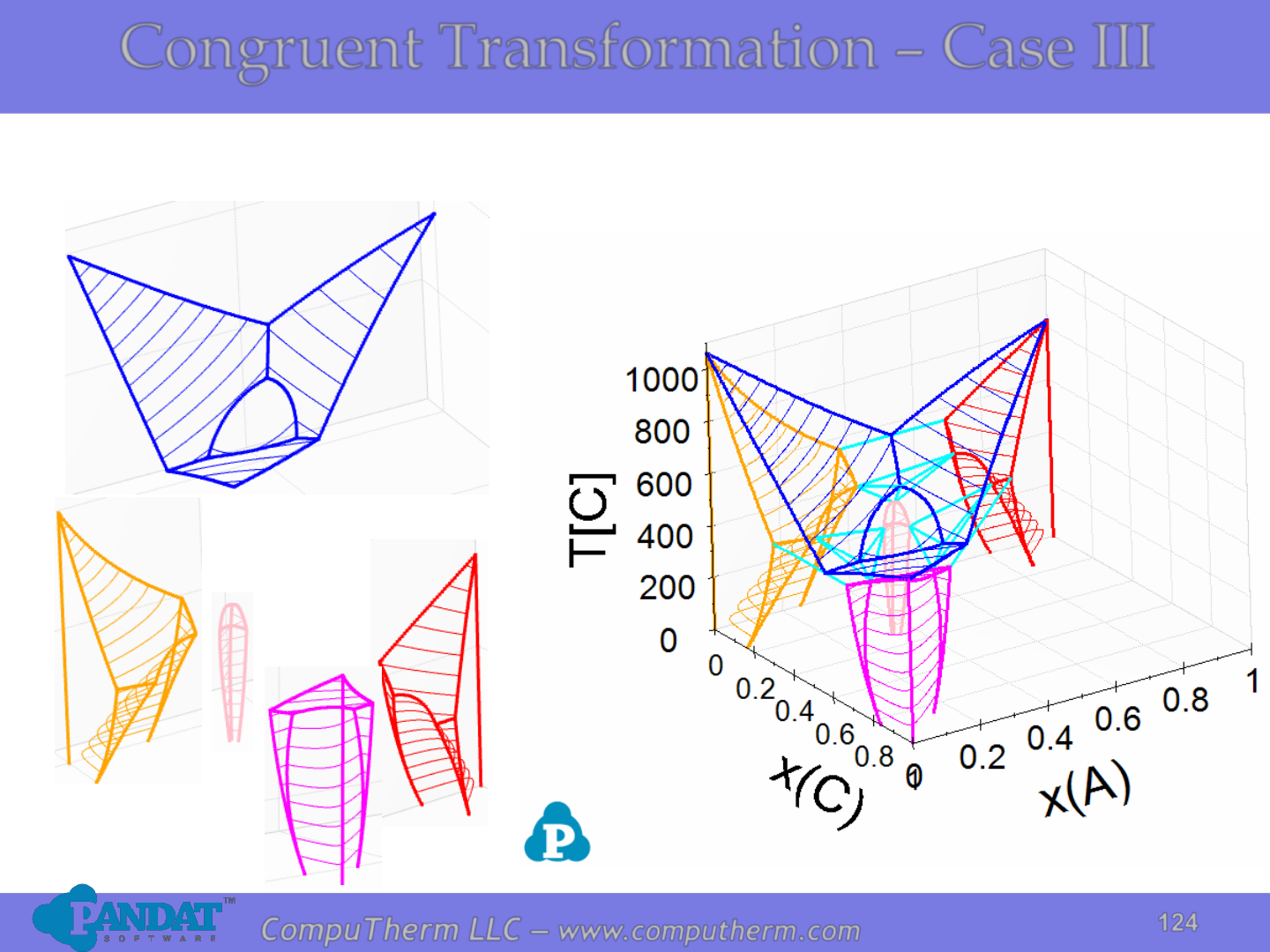
124
124
CompuTherm LLC – www.computherm.com
Congruent Transformation – Case III
Ternary phase fields in 3-D view
Liquid phase: Blue
Fcc phase: Red
Bcc phase: Orange
Hcp phase: Fuchsia
Delta phase: Pink
Invariant: Aqua
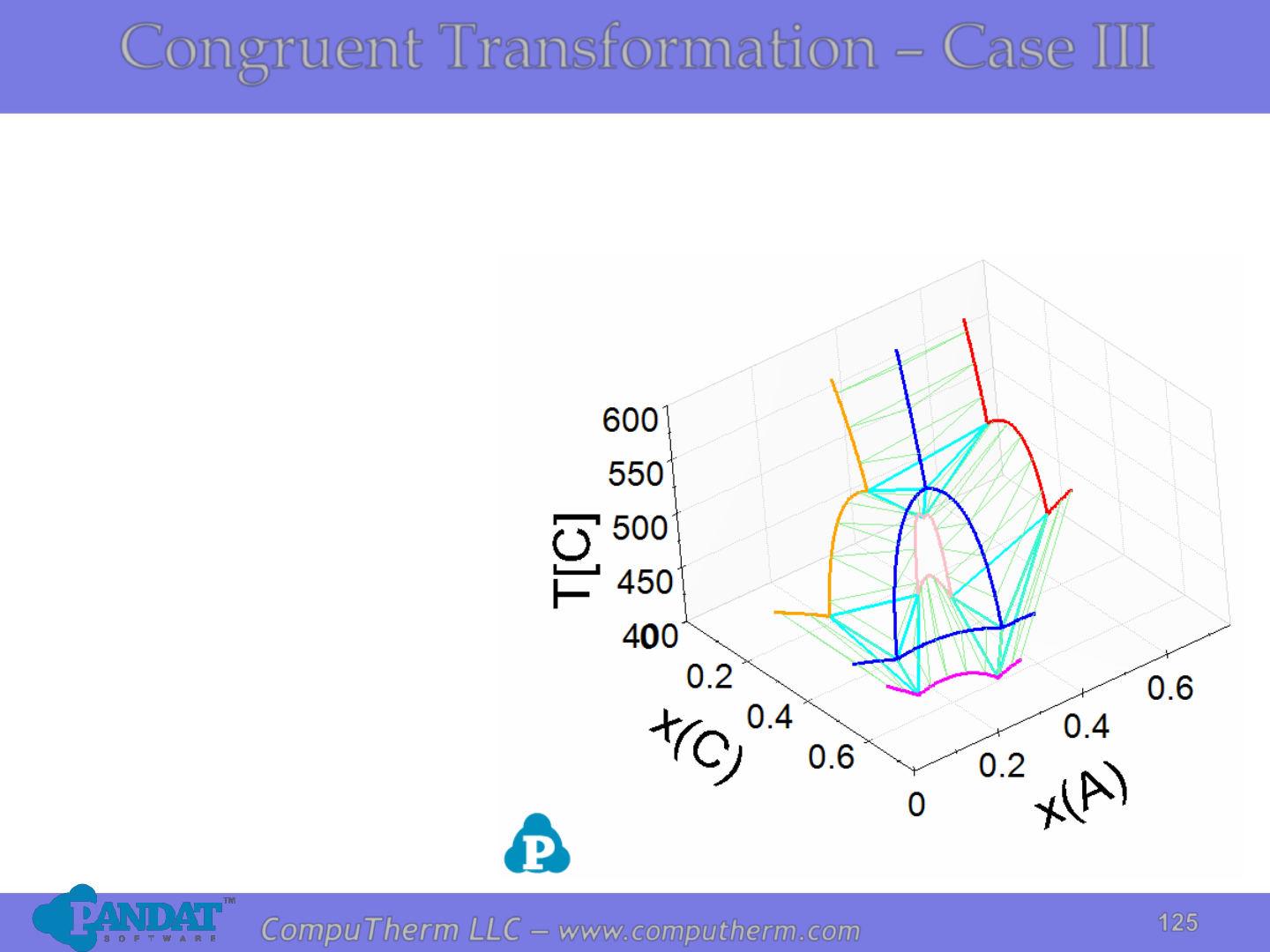
125
125
CompuTherm LLC – www.computherm.com
Congruent Transformation – Case III
Liquid involved Tie-triangle changes in ternary field
Liquid phase: Blue
Fcc phase: Red
Bcc phase: Orange
Hcp phase: Fuchsia
Delta phase: Pink
Invariant: Aqua
Tie-triangle: Green

126
126
CompuTherm LLC – www.computherm.com
Types of Ternary Phase Diagrams
• Isomorphous System
• Ternary Three-phase Equilibrium
• Ternary Four-phase Equilibrium
• Class I Reaction
• Class II Reaction
• Class III Reaction
• Congruent Transformation
• A Complex System
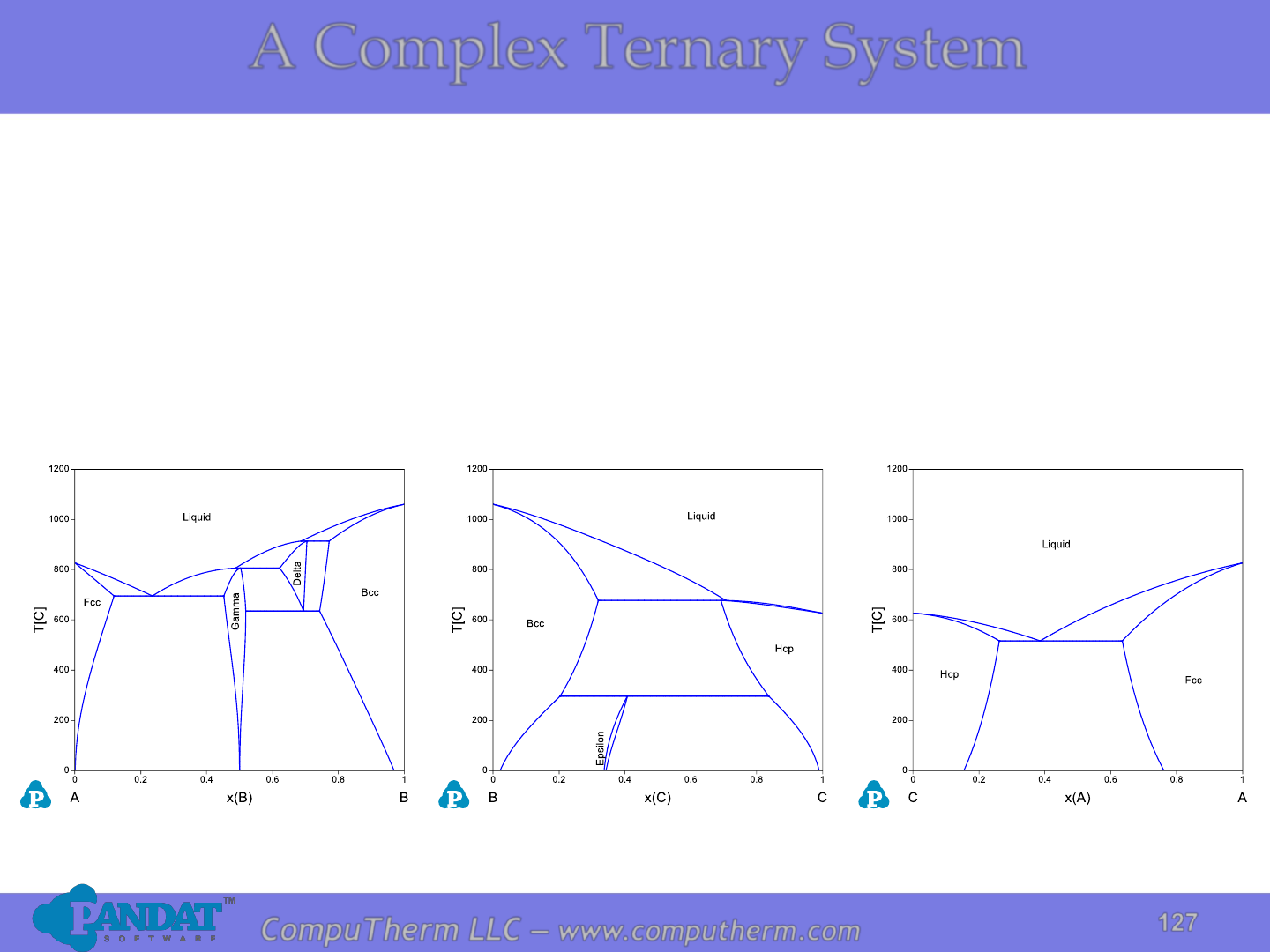
127
127
CompuTherm LLC – www.computherm.com
A Complex Ternary System
A complex ternary system involving all three
classes of four-phase equilibrium.
Binaries contain three solid solution phases: Fcc,
Bcc, and Hcp, and three intermetallic compounds:
Delta, Gamma and Epsilon.
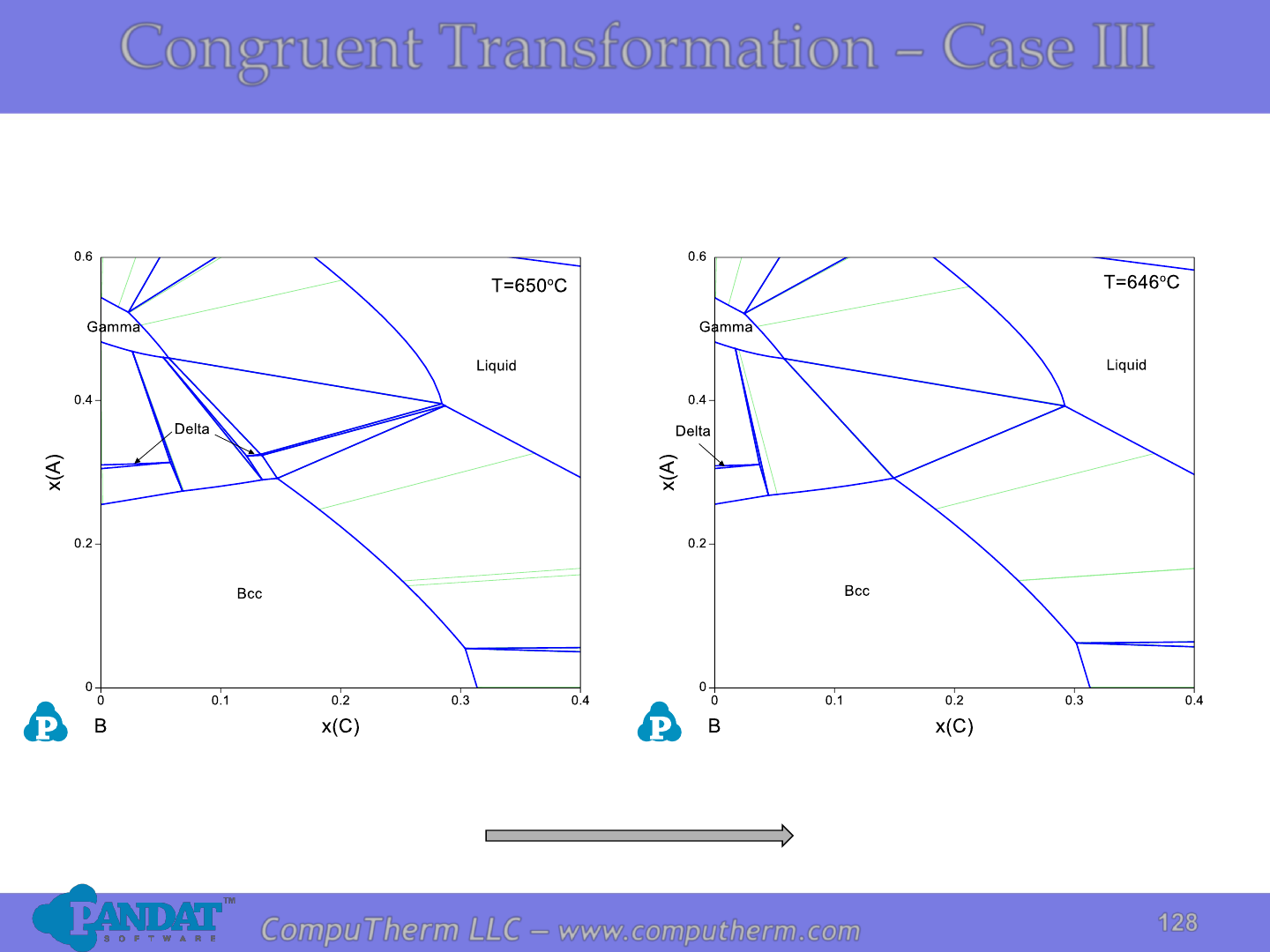
128
128
CompuTherm LLC – www.computherm.com
Congruent Transformation – Case III
Isothermal sections showing the invariant reaction 1 in detail.
Class I: Delta => Liquid + Gamma + Bcc
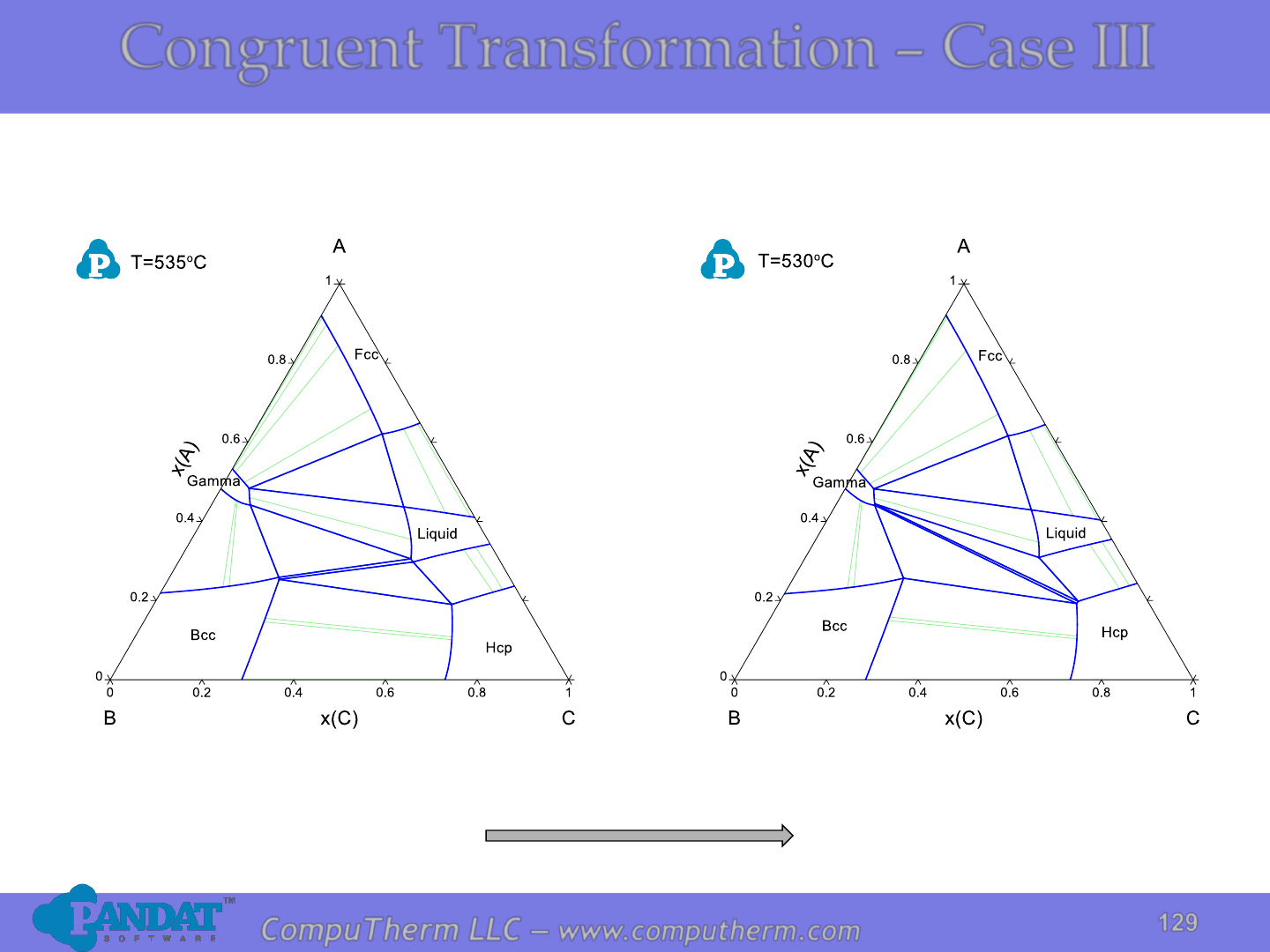
129
129
CompuTherm LLC – www.computherm.com
Congruent Transformation – Case III
Isothermal sections showing the invariant reaction 2 in detail.
Class II: Liquid + Bcc => Gamma + Hcp
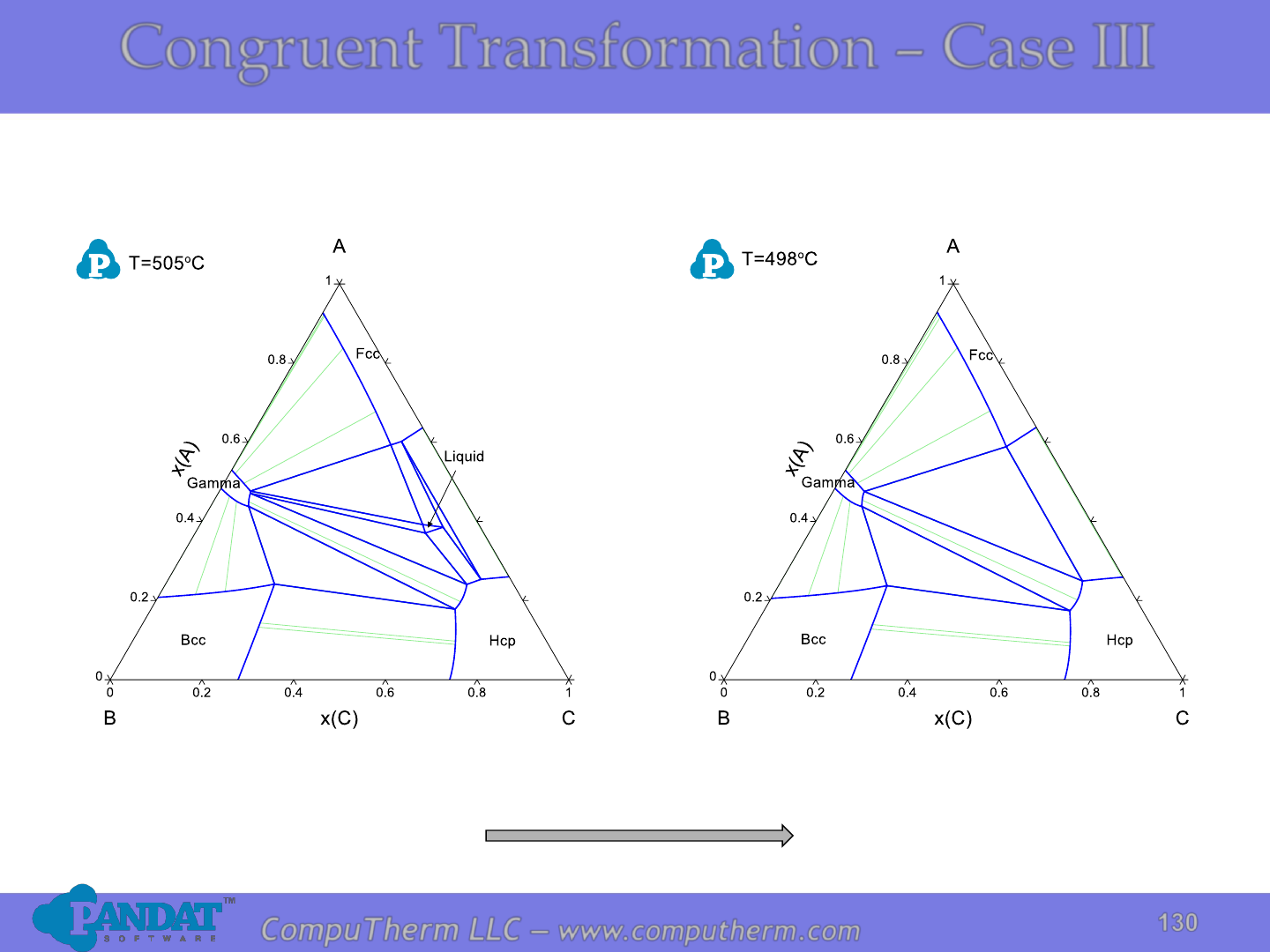
130
130
CompuTherm LLC – www.computherm.com
Congruent Transformation – Case III
Isothermal sections showing the invariant reaction 3 in detail.
Class I: Liquid => Gamma + Fcc + Hcp
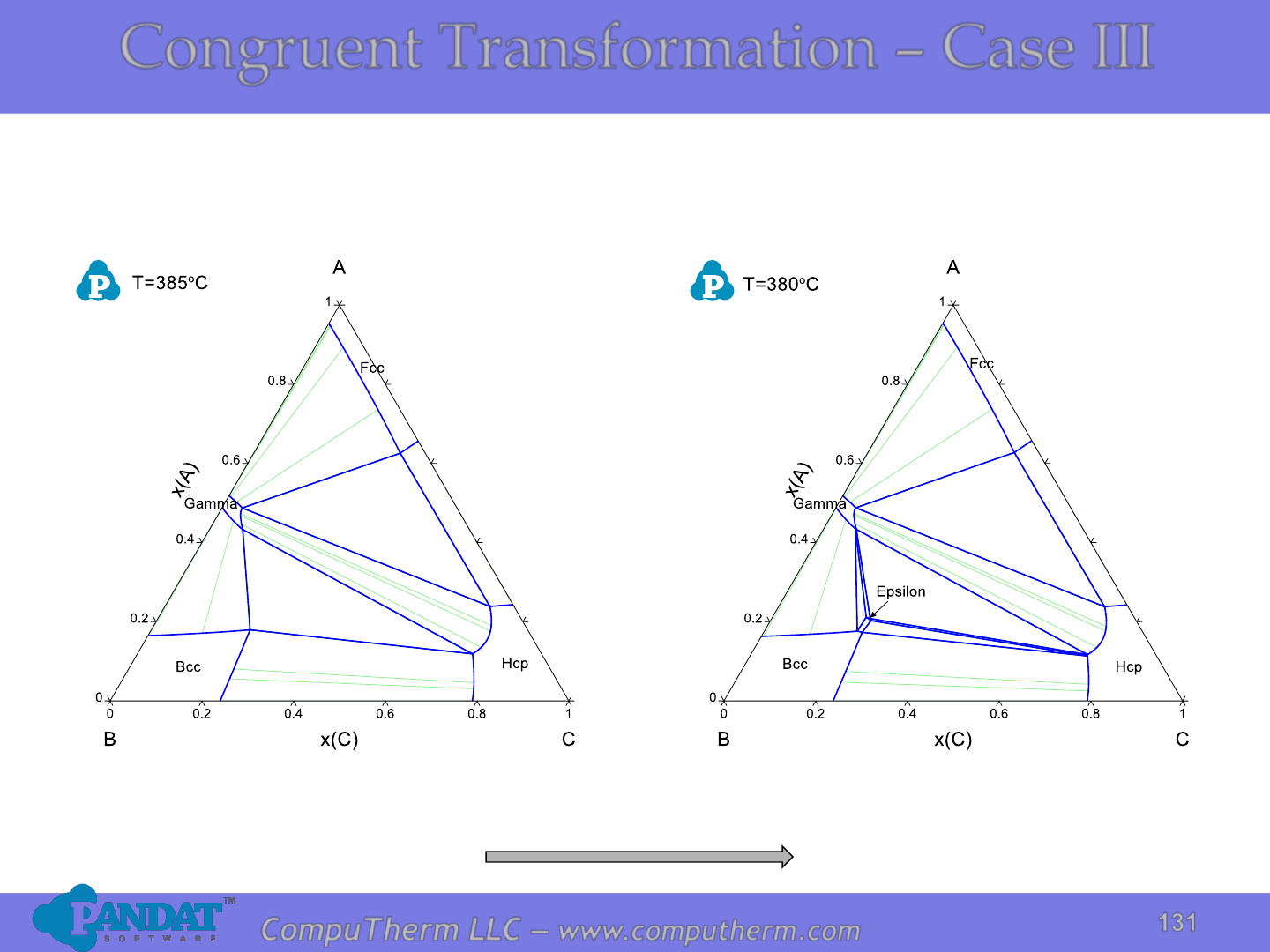
131
131
CompuTherm LLC – www.computherm.com
Congruent Transformation – Case III
Isothermal sections showing the invariant reaction 4 in detail.
This reaction occurs in the solid state.
Class III: Gamma + Bcc + Hcp => Epsilon
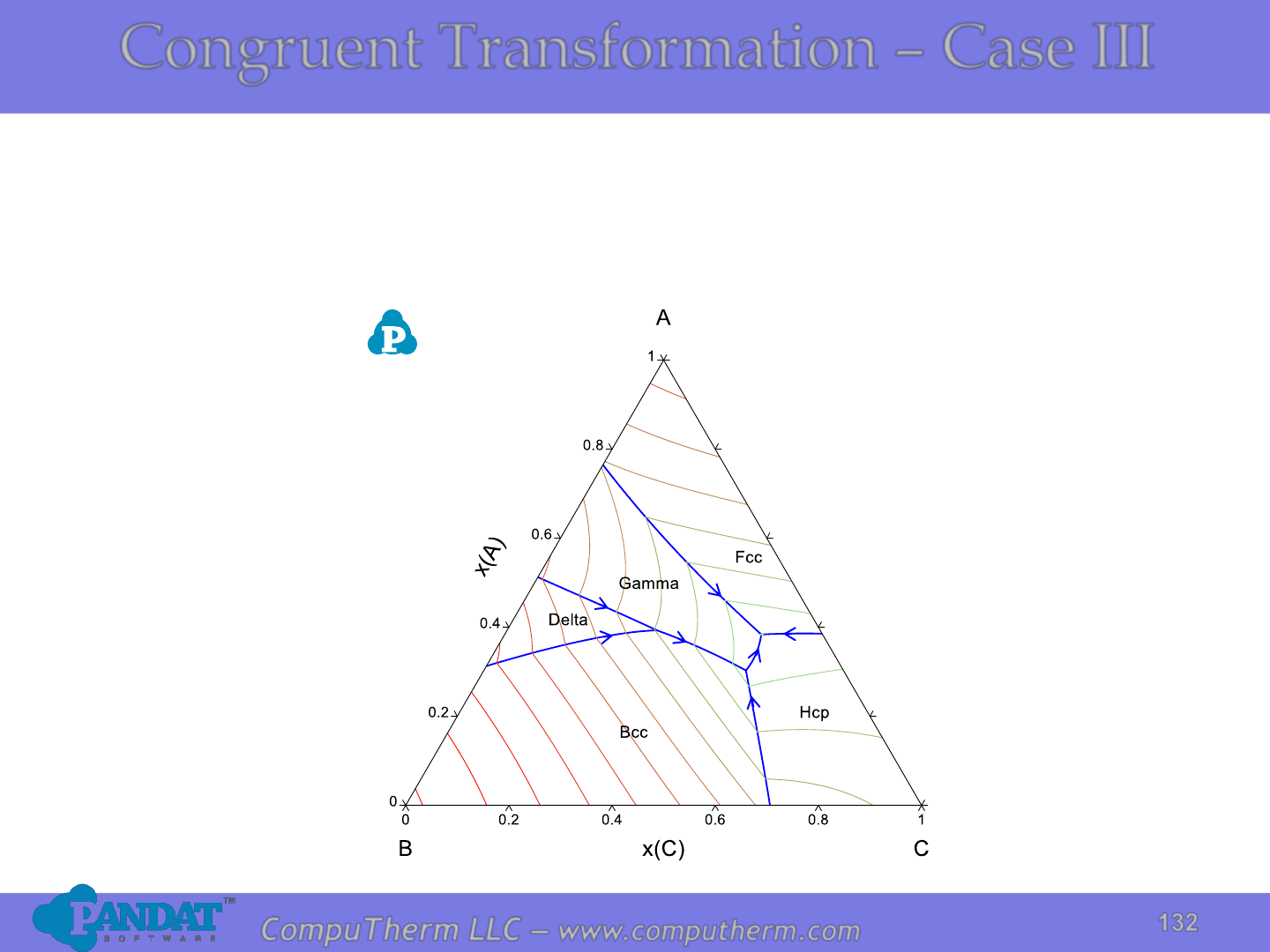
132
132
CompuTherm LLC – www.computherm.com
Congruent Transformation – Case III
There are three four-phase equilibria on the liquidus surface,
two Class I reactions and one Class II reaction.
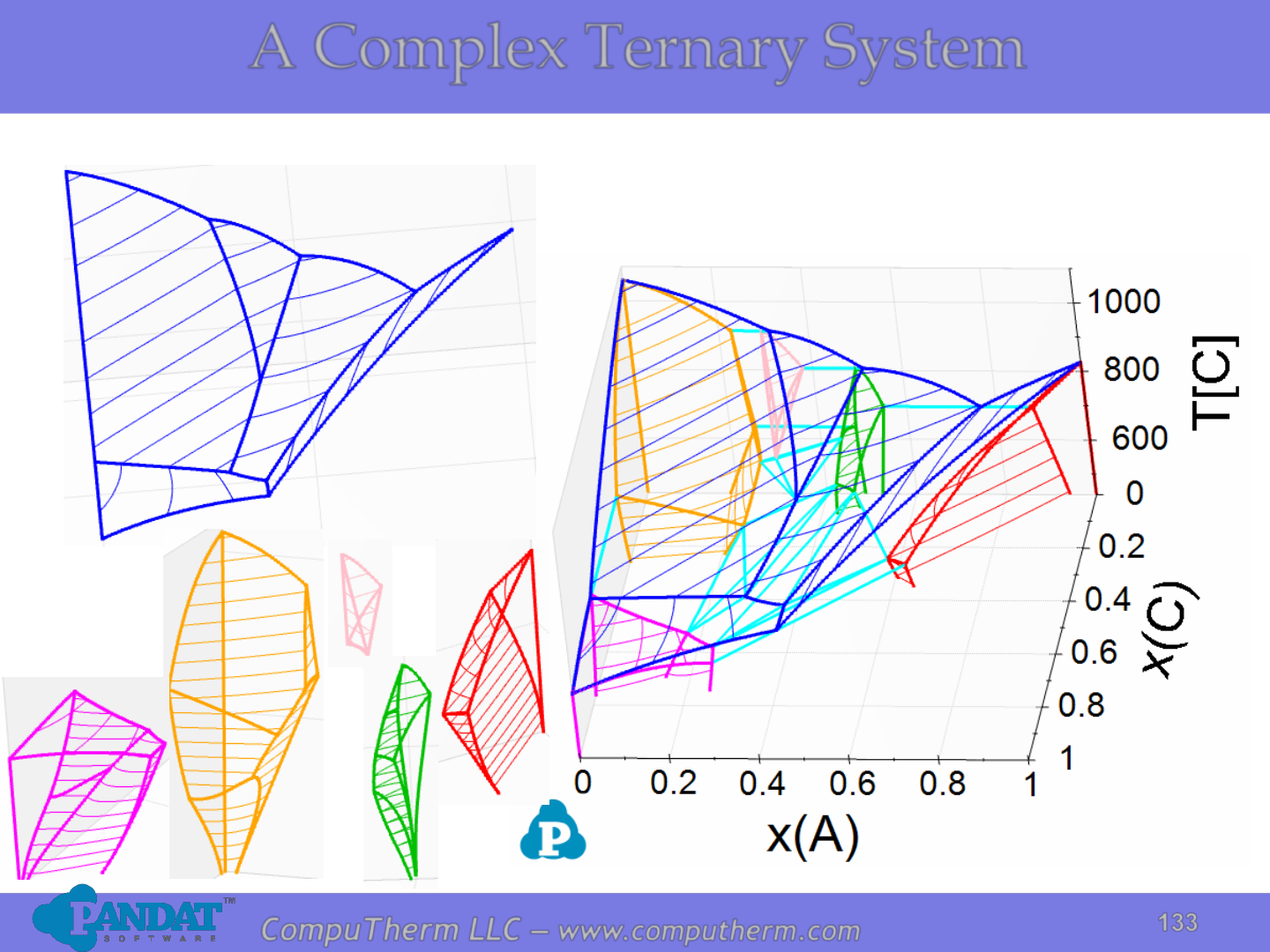
133
133
CompuTherm LLC – www.computherm.com
A Complex Ternary System
Ternary phase fields in 3-D view above 440
o
C
Liquid phase: Blue
Fcc phase: Red
Bcc phase: Orange
Hcp phase: Fuchsia
Delta phase: Pink
Gamma phase: Green
Invariant: Aqua
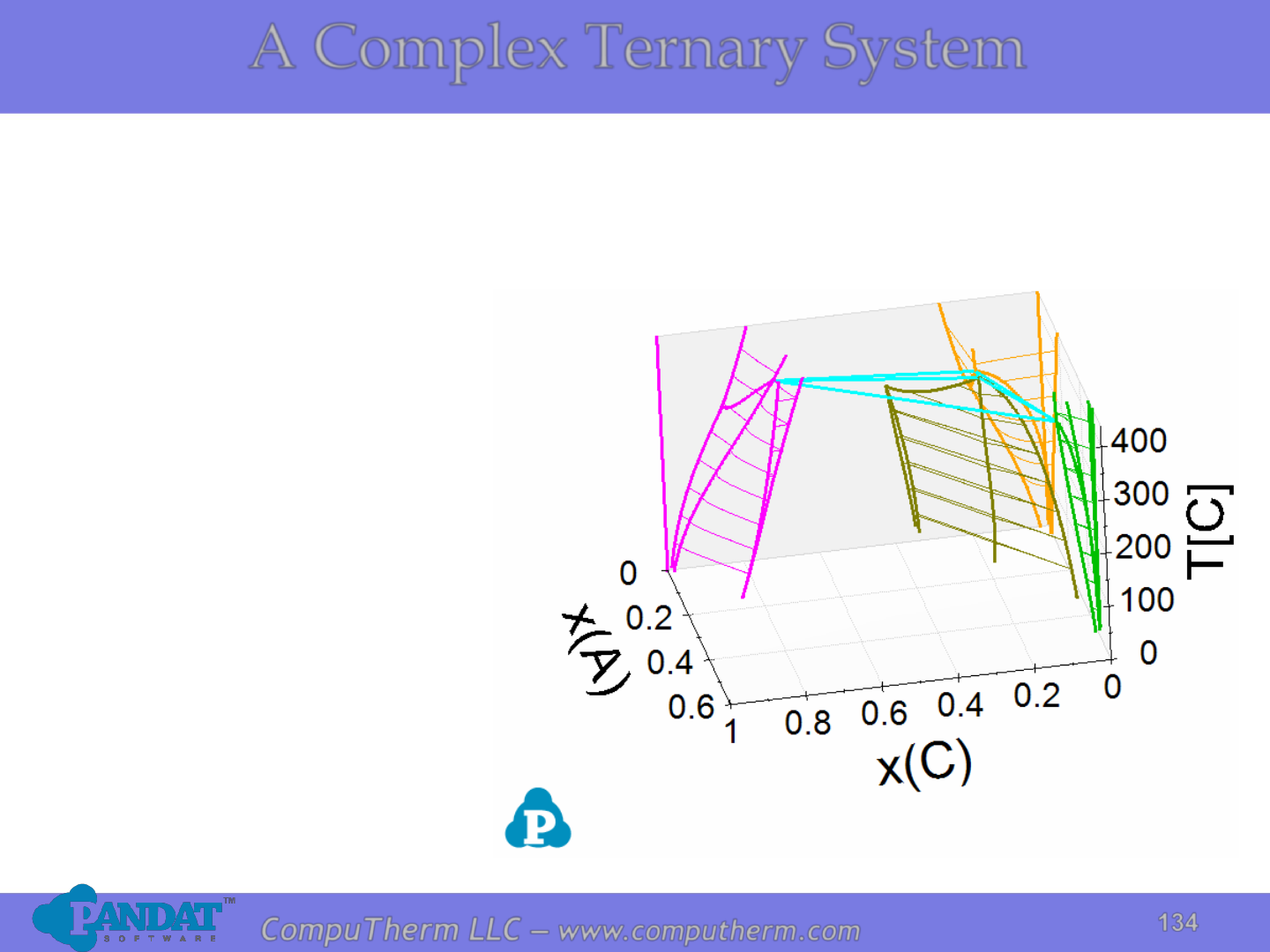
134
134
CompuTherm LLC – www.computherm.com
A Complex Ternary System
Ternary phase fields in 3-D view below 440
o
C
Bcc phase: Orange
Hcp phase: Fuchsia
Epsilon phase: Olive
Gamma phase: Green
Invariant: Aqua

135
135
CompuTherm LLC – www.computherm.com
Acknowledgement
• Many of the slides are reproduced based on the
book: Phase Diagrams in Metallurgy, Frederick
N. Rhines.

136
136
CompuTherm LLC – www.computherm.com
For Download
• The PowerPoint file and related thermodynamic
database files are available for downloading
under the directory: Resources/Downloads.
• Thank you for your interest.
